What's New in IntelliJ IDEA 2025.1
IntelliJ IDEA 2025.1 delivers full Java 24 support, introduces Kotlin notebooks, and makes K2 mode the default, marking a major step toward the best Kotlin experience. Debugging is more powerful, with pause and resume functionality for watch evaluations, while numerous other refinements across the IDE enhance productivity, code quality, and overall developer comfort.
IntelliJ IDEA goes AI
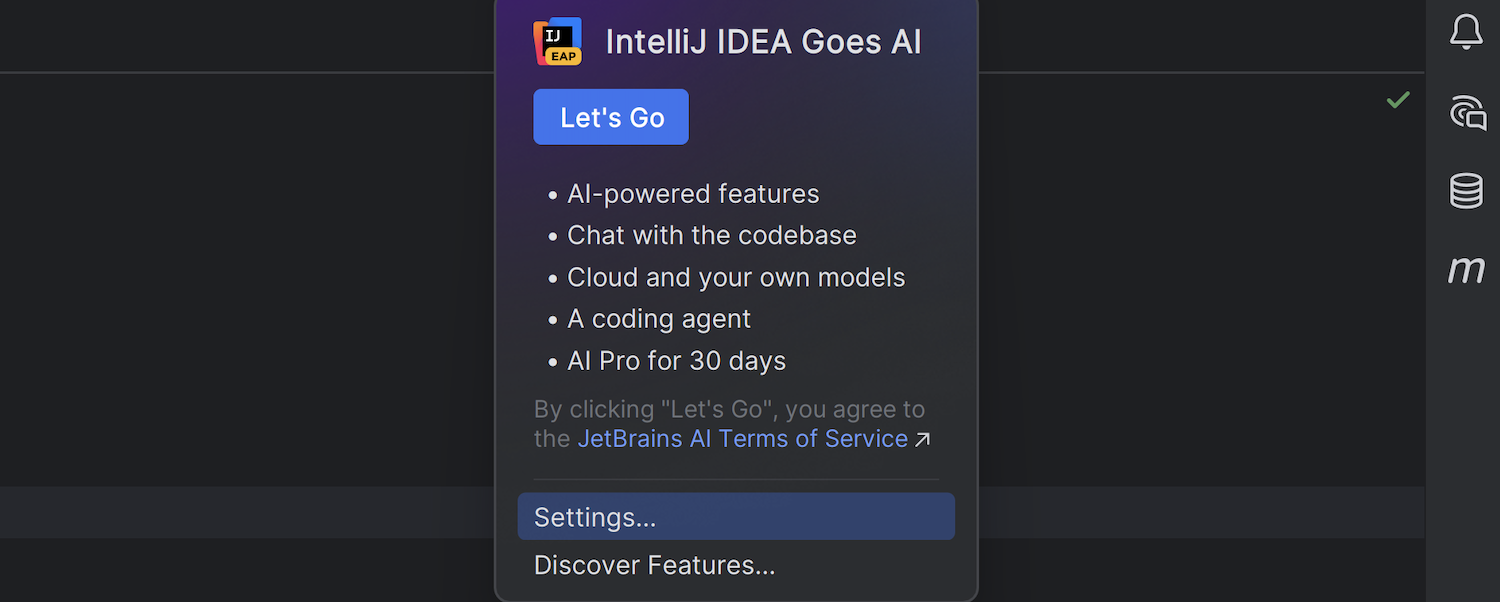
JetBrains AI has received a major upgrade, bringing both AI Assistant and Junie under a single subscription. With this release, all JetBrains AI features are accessible for free in our IDEs, with unlimited use for some, such as unlimited code completion and local model support, and limited credit-based access to others. We're also introducing a new subscription system that makes it easy to scale up as needed with the AI Pro and AI Ultimate tiers.
This release introduces major enhancements to boost productivity and reduce repetitive work. Updates include smarter code completion, support for new cloud models like OpenAI GPT-4.1 (сoming soon), Claude 3.7 Sonnet, and Gemini 2.0 Flash, advanced RAG-based context awareness, and a new edit mode for multi-file edits directly from the chat. Learn more.
Key highlights
Java 24 support
Version 2025.1 provides full support for all features in the latest Java 24 release, ensuring a seamless experience with the newest language updates. Stream gatherers, now a stable feature, are integrated into the stream debugging workflow. All other features, whether experimental, in preview, or finalized, are supported as well, so you can leverage them in your projects. Learn more.
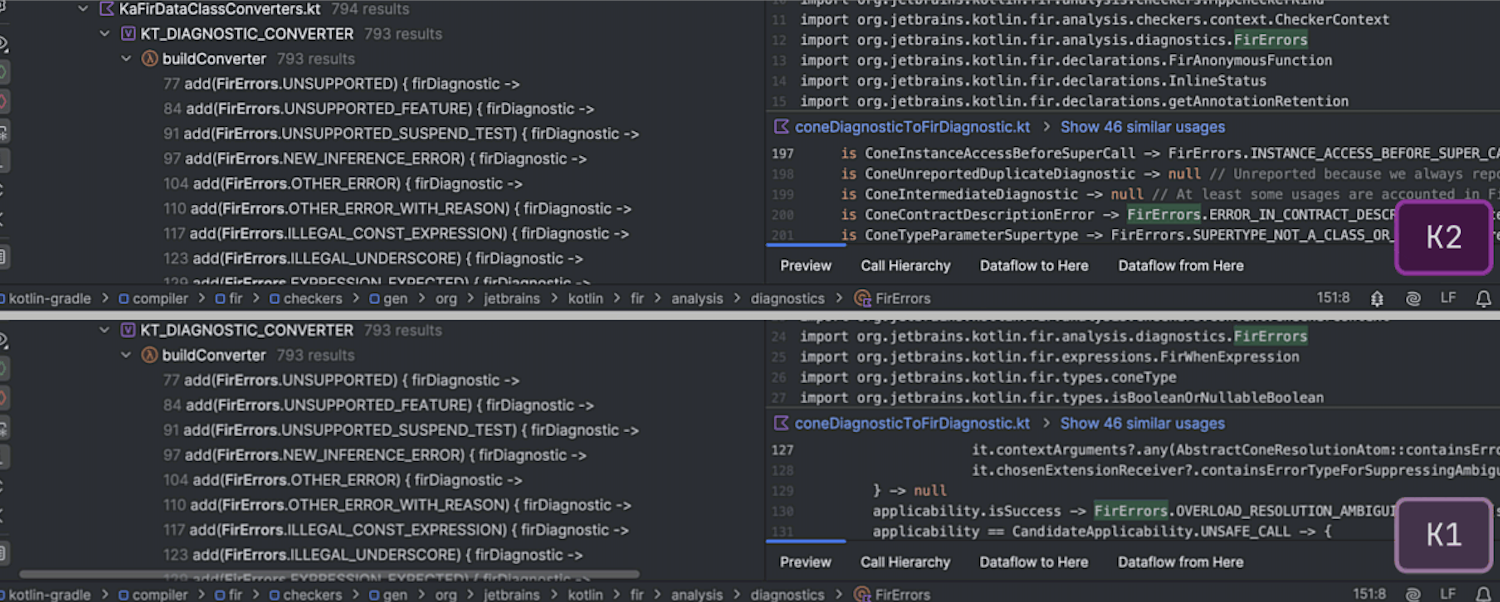
Kotlin K2 mode by default
In this release, K2 mode is enabled by default. This is a major milestone built on all the progress we've made toward improving code analysis, memory efficiency, and overall performance for Kotlin development. With full support for all Kotlin 2.1 (and newer) language features, K2 mode is a significant step forward that will allow us to continue improving the IDE's language support.
While active users of K2 mode are already seeing a smoother experience, we are still working on some actions, such as certain refactorings and infrequently used inspections. However, our commitment to quality remains stronger than ever: We are actively working to address all outstanding issues and perfect the experience for developers. If you run into any challenges, we'd love to hear about them and help. Check out this blog post for more details on the current state of K2 mode.

Control over watch evaluations
You can now pause and resume the evaluation of watches to control possible side effects of watch computations. Simply right-click a watch during evaluation and select Pause Watch. While paused, it won't evaluate and report errors. To resume the evaluation process, click Resume Watch in the context menu.
Kotlin notebooks for everyone
Kotlin Notebook, a new interactive environment for JVM developers, is now a built-in feature of IntelliJ IDEA! Kotlin notebooks are perfect for a wide range of tasks – from real-time prototyping, presenting, log parsing, and documentation writing to in-depth data analysis and visualization.
Learn more.
User experience

New terminal architecture Beta
The 2025.1 release introduces a reworked terminal architecture, which is available in Beta. The terminal now runs on a stable, standards-compliant core and uses the IDE's editor to render the UI. This change lets us introduce new features while preserving compatibility and performance across various platforms, whether local or remote. Get more details about our plans and progress in this blog post.
Merged main menu in the main toolbar on Windows and Linux
For Windows and Linux users, the IDE now offers a new option to merge the main menu with the main toolbar, creating a more streamlined interface.
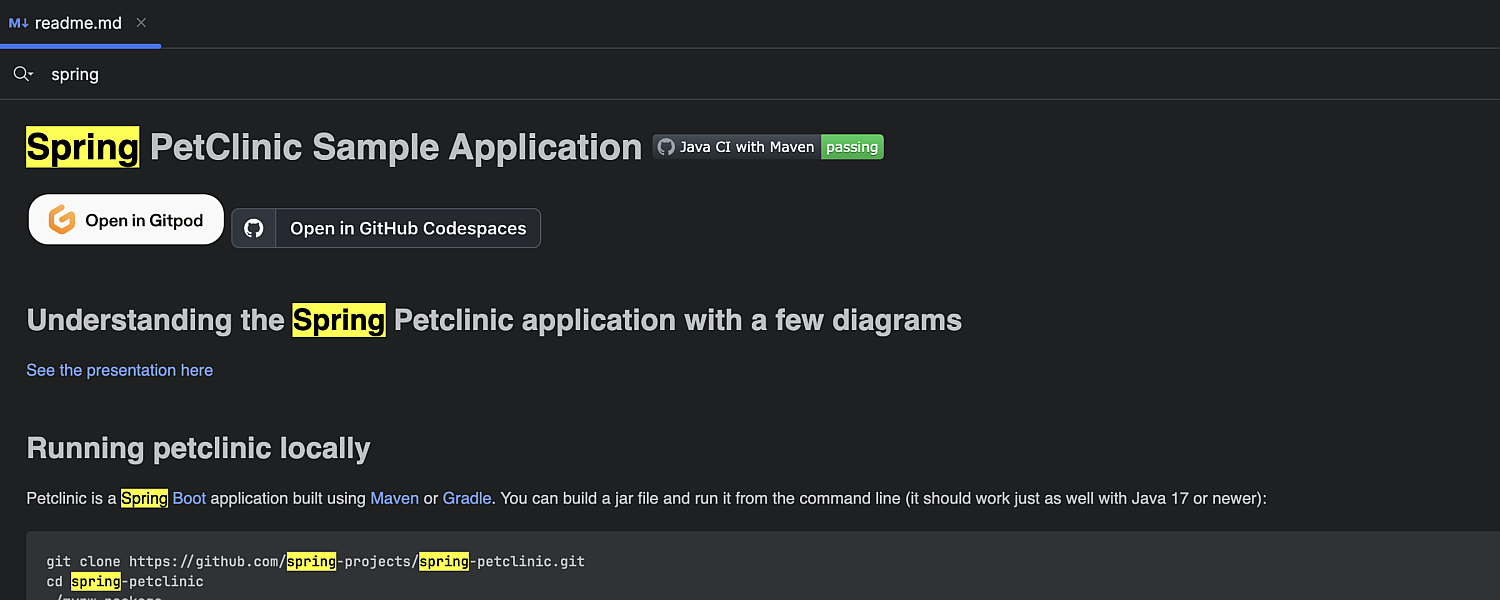
Search functionality in Markdown previews
In IntelliJ IDEA 2025.1, you can search within Markdown previews. Since README.md previews are often the first thing you see when opening or cloning a project, this update makes it easier to find key information instantly.
Native OS file dialogs on Windows
IntelliJ IDEA now defaults to using native Windows file dialogs instead of the IDE's custom implementation. This gives you a more familiar experience when opening or saving files. If you prefer the previous behavior, you can restore it in Advanced Settings | User Interface.

New file creation in the Project tool window
Creating a new file is now more convenient. You can access the popup listing available file templates directly from the Project window toolbar via the + icon, and the search field lets you quickly filter and find the file type you need.
Automatic plugin updates
You can set IntelliJ IDEA to automatically update plugins in the background. It will download available updates and apply them on the next IDE restart without additional notifications. You can enable automatic updates by clicking the Enable auto-update checkbox in the update dialog or via File | Settings | Appearance & Behavior | System Settings | Updates.
Kotlin
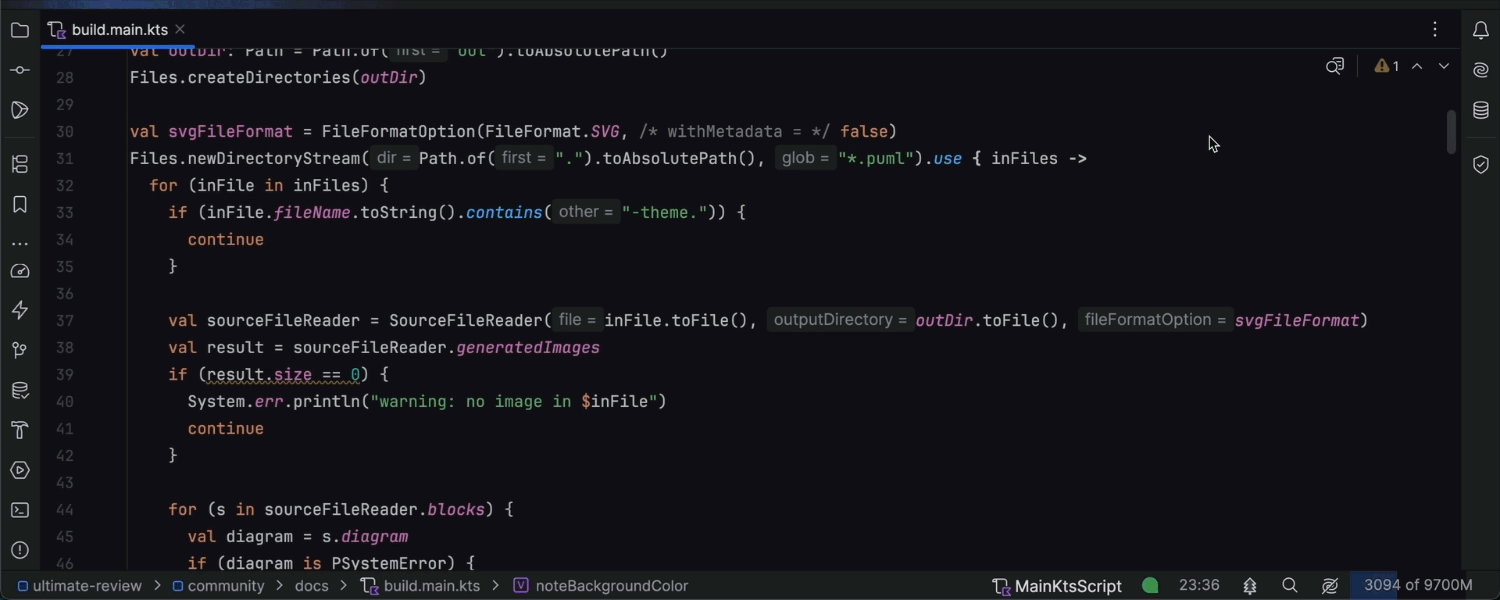
Enhanced dependency resolution in main.kts
IntelliJ IDEA 2025.1 improves the stability and predictability of dependency resolution in Kotlin build scripts. Previously, resolution ran in parallel with code highlighting, causing delays and delivering unclear feedback. Now, you can track its progress using the Load script dependencies button. Scripts without any dependencies open immediately and are ready for highlighting without unnecessary processing.

Quick-fix for non-imported KDoc names
IntelliJ IDEA 2025.1 introduces a long-awaited quick-fix to simplify writing KDoc. The IDE can now automatically insert qualified names in KDoc links.
Hints about code alterations caused by Kotlin compiler plugins
With this update, IntelliJ IDEA now provides clearer insights into modifications introduced by compiler plugins, making their behavior more transparent. Kotlin features several powerful compiler plugins, such as kotlinx.serialization and all-open, that are used across various domains and can alter how Kotlin code behaves. Learn more.
Scala
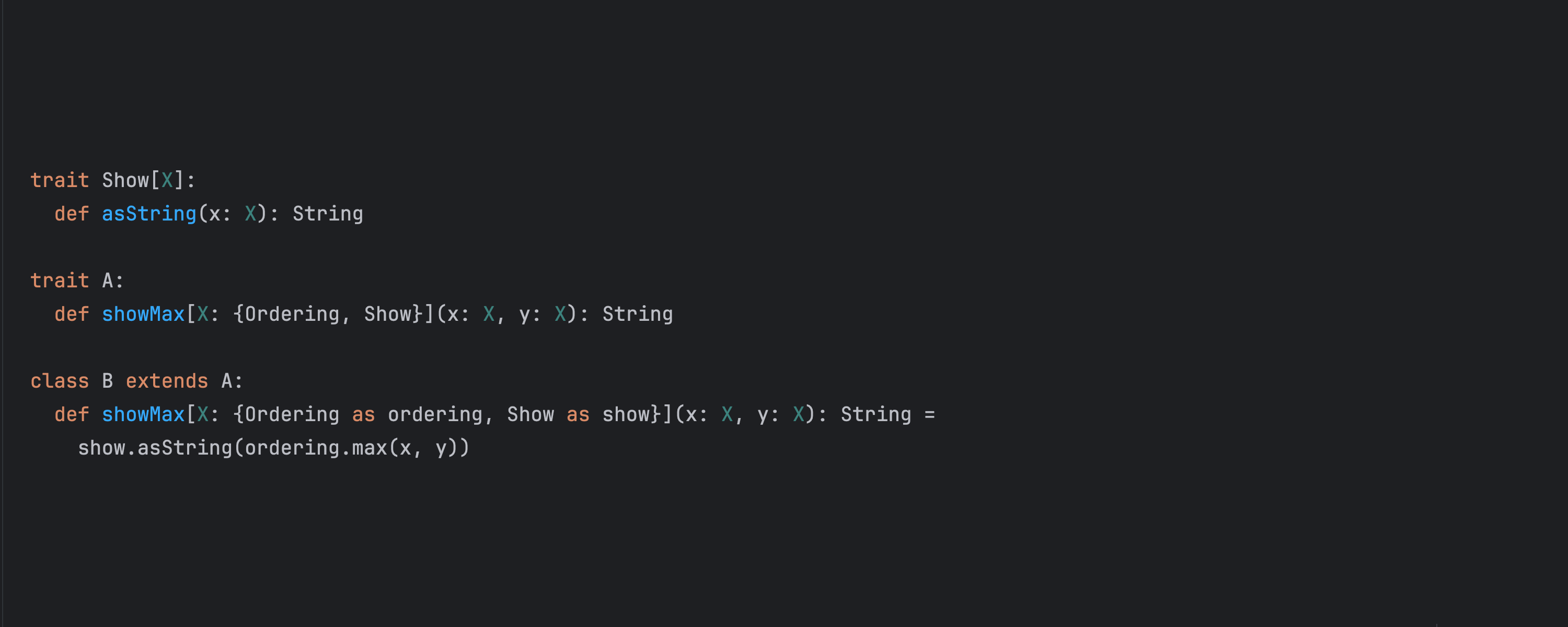
Scala 3 support
This release includes improved support for the new syntax for context bounds and givens (SIP-64). We've also improved the support for named tuples (SIP-58) and introduced support for for-comprehension syntax (SIP-62). We've fully adopted Scala 3's changes to implicit resolution logic. There are multiple other smaller bug fixes and improvements, and Scala 3 code is now correctly highlighted in code snippets in Markdown files.

Improved debugging experience
The debugger no longer encounters issues stopping at breakpoints inside lambdas in traits and inside lazy vals in try…catch blocks.
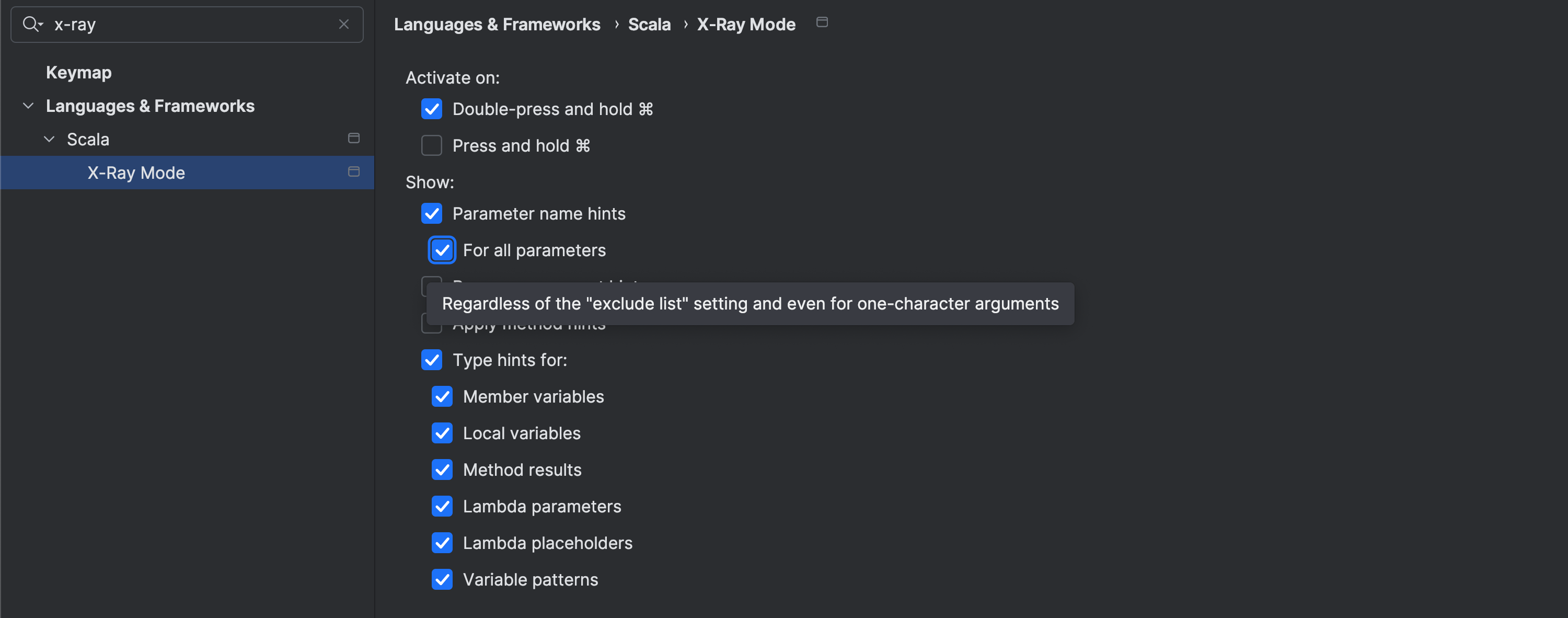
Refined code highlighting for Scala
In the 2024.3 release, we introduced support for transparent inline methods in Scala 3. Now, as we continue to work on support for Scala macros, we offer support for Scala 2 macro types. We've also improved type hints for variable patterns, generators, and literal parameters, as well as type info for underscore parameters and kind-projector syntax.
Enhancements for sbt projects
We've made several improvements to the new separate production and test modules. A new Generate sbt managed sources action helps you avoid situations when good code is marked red because it relies on sources generated during project import. Additionally, the New Project wizard now suggests downloading the JDK for new sbt projects.
Other improvements
Code completion can now provide partial results during indexing. Additionally, when you use Code With Me for Scala projects, you will see that the auto-import quick-fix is offered only after code is edited on the host.
Frameworks and technologies
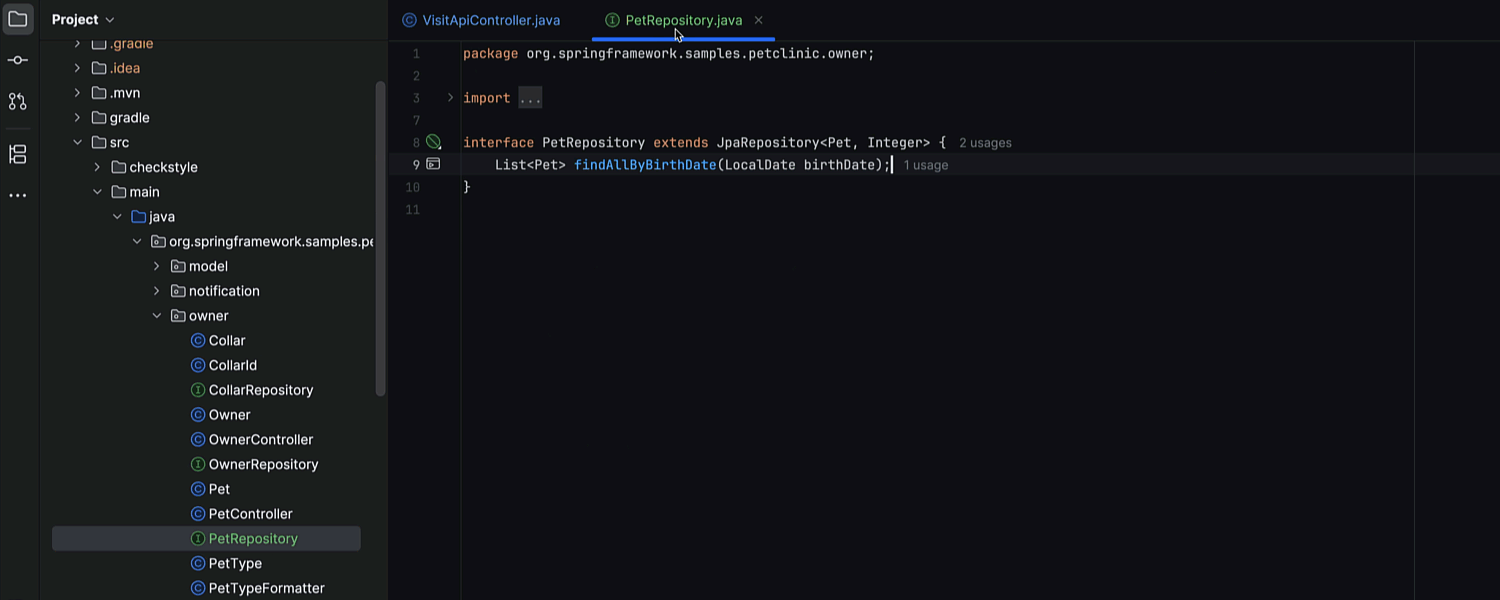
Automatic creation of nonexistent Spring Data repositories Ultimate
IntelliJ IDEA now automatically creates Spring Data repositories for you. Simply start typing the entity name, and if the repository doesn't exist, the IDE will suggest creating one. Choose the repository type and seamlessly continue your work by adding derived query methods and processing the extracted data.
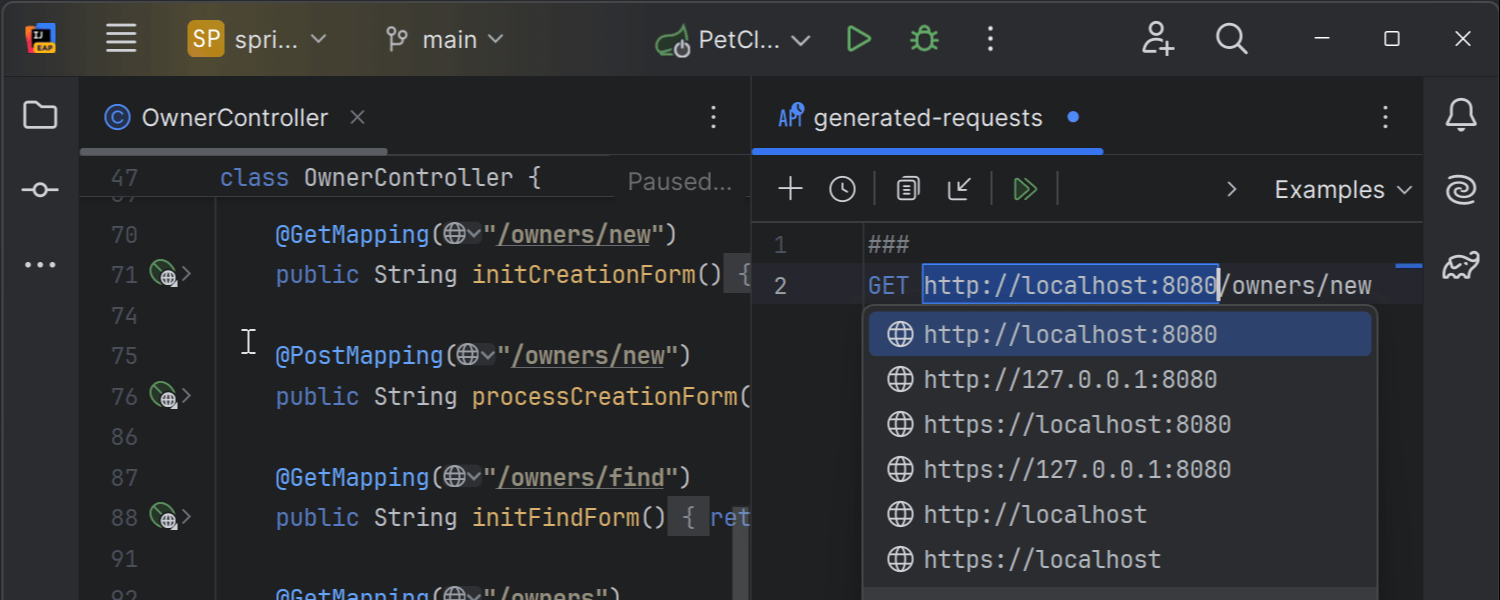
Enhanced user experience for generated HTTP requests Ultimate
The HTTP Client now opens HTTP requests generated from code in the right-hand editor split, which means you no longer need to review them in a separate tab.

Support for Liquibase in the Logical code structure view Ultimate
With the Logical code structure view in IntelliJ IDEA 2025.1, you can now enjoy a more meaningful structure representation and streamlined navigation tailored specifically for Liquibase change sets. Easily explore and manage your change sets with an intuitive overview that highlights their logical hierarchy, helping you stay organized and productive when working on database schema changes.
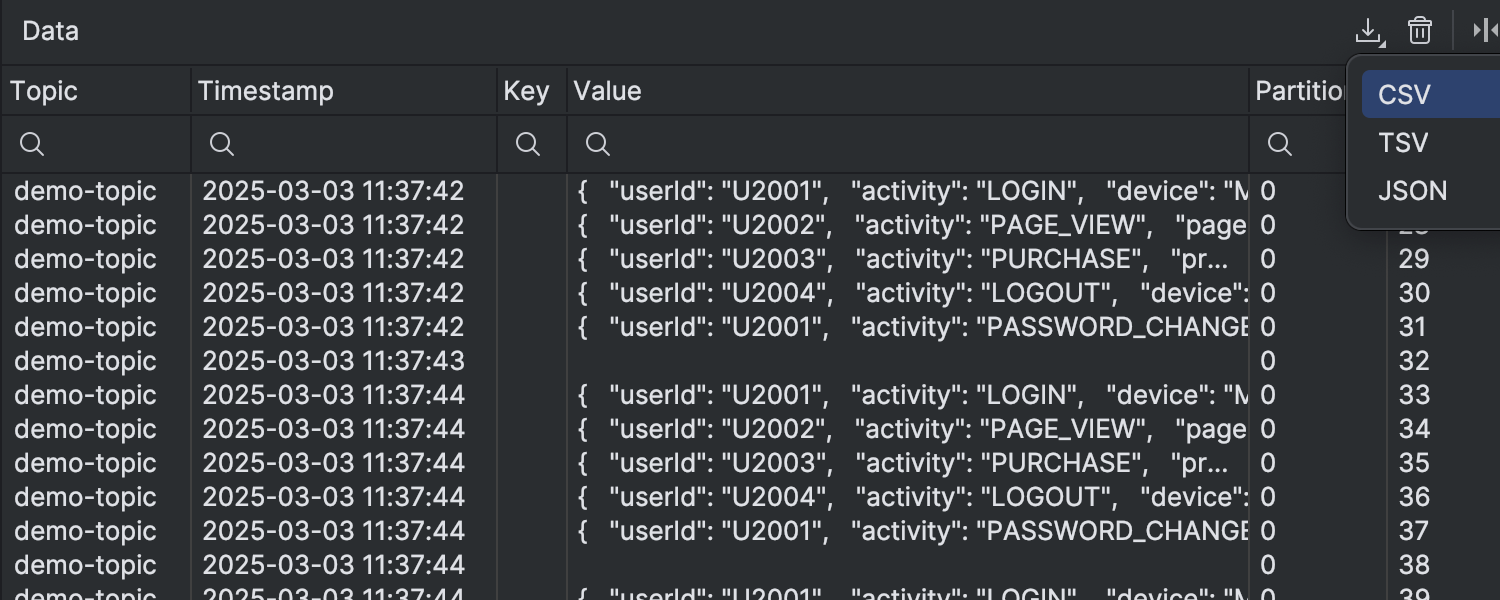
Option to export Kafka records directly to JSON, CSV, and TSV Ultimate
IntelliJ IDEA now allows you to export Kafka records directly to JSON, CSV, and TSV files, making it easier to analyze and share streaming data. The IDE can save complete record details, including topic, timestamp, key, value, partition, and offset, in widely used formats. With this update, you can diagnose issues faster, verify data integrity, enable advanced analysis, and streamline collaboration, as exporting Kafka records helps ensure data is accessible and actionable. By reducing time to resolution and improving data transparency, this enhancement provides a more efficient and effective Kafka experience.

OpenTofu gutter actions Ultimate
IntelliJ IDEA 2025.1 introduces interactive gutter actions for.tofu files, which are used to define cloud resources in OpenTofu, an open-source infrastructure-as-code (IaC) framework. With this new gutter integration, you can execute key OpenTofu commands directly from the editor – no need to switch to the terminal. A clickable icon in the editor's gutter opens a menu of common actions like Init, Validate, Plan, Apply, and Destroy, putting your infrastructure commands at your fingertips.
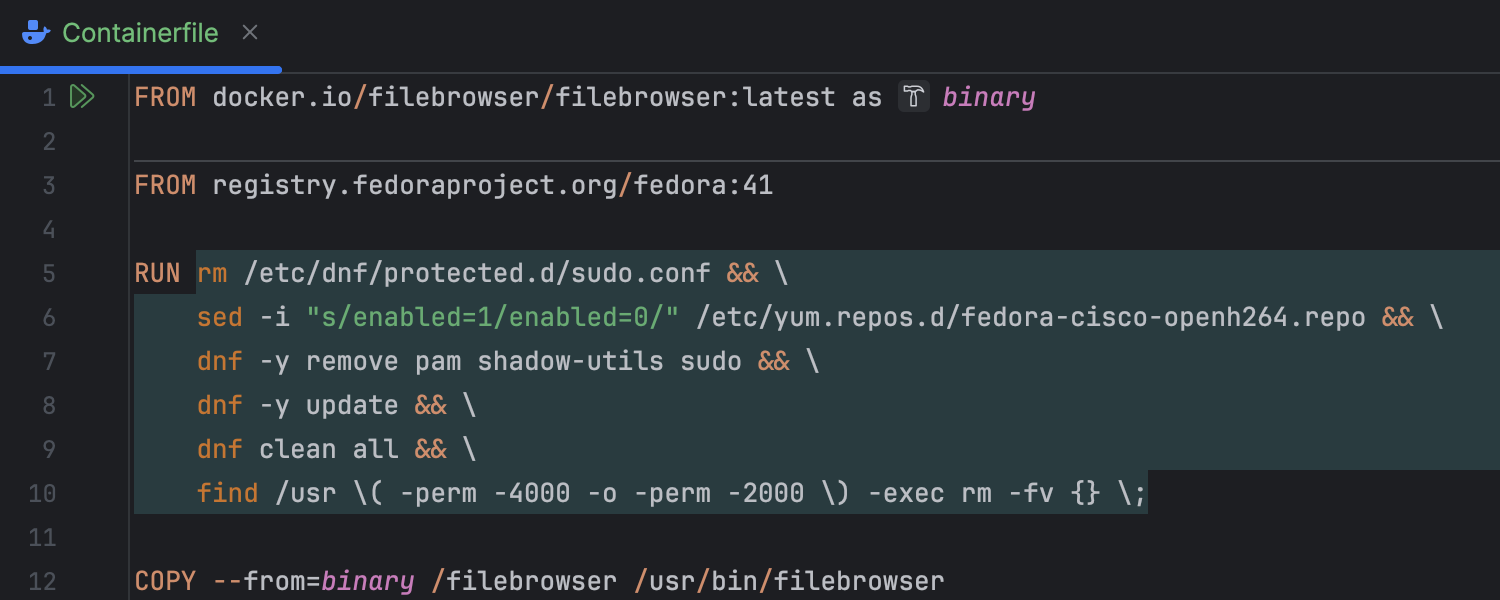
Containerfile support Ultimate
IntelliJ IDEA now recognizes Containerfiles natively, offering syntax highlighting, linting, and snippet suggestions and ensuring a smooth developer experience for anyone juggling Docker, Podman, and Buildah in the same environment. This update eliminates the friction that previously forced you to either change the name "Containerfile" to "Dockerfile" and lose access to Podman-specific features or just plow through with basic text editing.
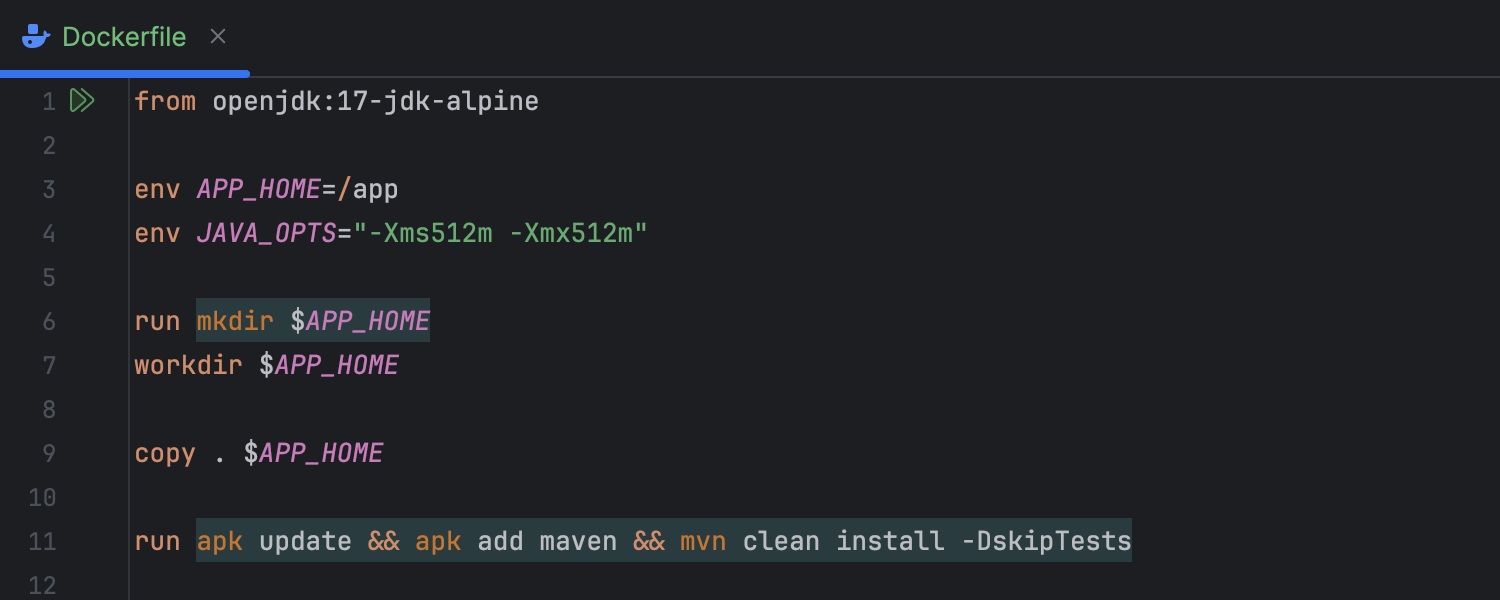
Support for lowercase instructions in Dockerfiles Ultimate
IntelliJ IDEA 2025.1 allows you to write directives in lowercase in addition to the conventional uppercase. Previously, the IDE recognized commands like FROM, RUN, and COPY as Dockerfile instructions. Now, you're also free to use the lowercase from, run, and copy to accommodate specific commands, plugins, corporate standards, or personal preferences.
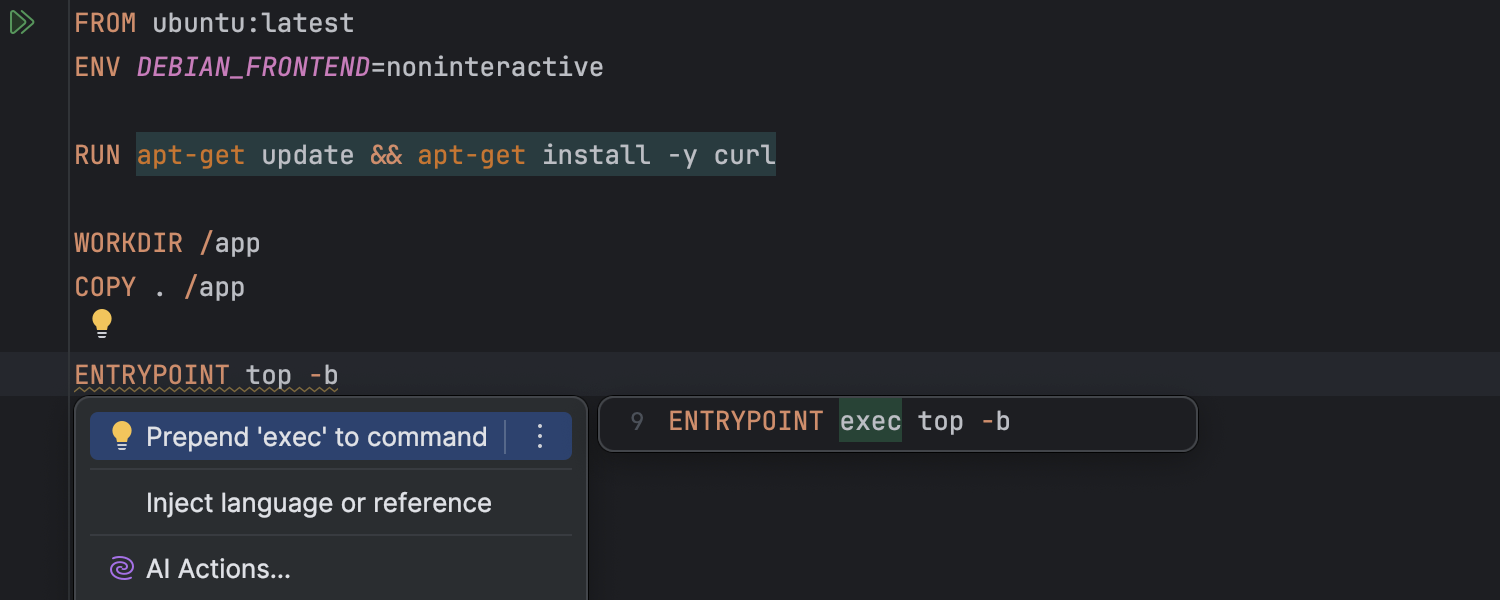
New inspection for reliable ENTRYPOINT initialization with exec Ultimate
We've introduced a new Dockerfile inspection that ensures your ENTRYPOINT is correctly initiated with exec. Using exec allows signals sent via docker stop to reach the main process directly, preventing lingering and keeping processes from being improperly terminated. If you omit exec, your application may run as a child process and fail to receive signals like SIGTERM, making shutdown unreliable. This inspection highlights incorrect ENTRYPOINT usage and guides you toward best practices, helping you maintain cleaner Dockerfiles and more robust container life cycles.
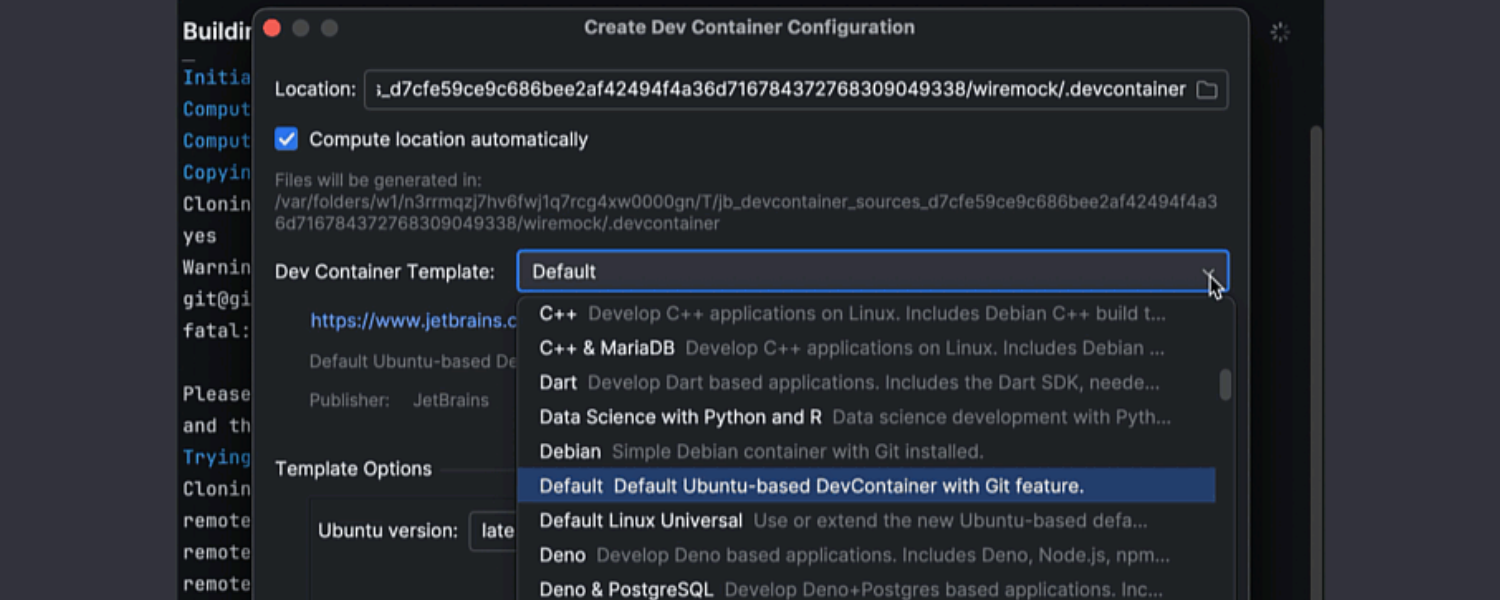
Git-ready Ubuntu image for easier Dev Container setup Ultimate
When you clone a repository without a Dev Container configuration, the IDE's New Project wizard now offers the option to use an optimized Ubuntu-based container that has Git pre-installed. This update eliminates common issues like Git being missing, reducing setup time so you can focus on coding.

Support for userEnvProbe for Dev Containers Ultimate
The IDE now supports the userEnvProbe option in devcontainer.json, making it easier to replicate your local shell environment inside Dev Containers. This feature automatically imports settings like aliases, environment variables, and authentication tokens during container startup, ensuring a seamless development experience without performance overhead on every subprocess. Preserving familiar configurations helps teams onboard quickly and work efficiently in containerized environments.

Faster WSL workflows and easier cross-platform development Ultimate
We are enhancing JetBrains IDEs to work better in heterogeneous environments – places where your local operating system is different from the one where your project actually lives. A common example of such an environment, and the first we've added support for, is WSL (the Windows Subsystem for Linux), and we'll be adding more in the future.
If your project is located in WSL, IntelliJ IDEA 2025.1 automatically uses the JDK available inside it. This makes file indexing when using WSL from Windows up to 30% faster, with no noticeable lag or freezing. Symlinks are also fully supported, and we're continuing to improve support for Maven, Gradle, Git, and other tools to ensure they work seamlessly in these mixed setups.
Build tools
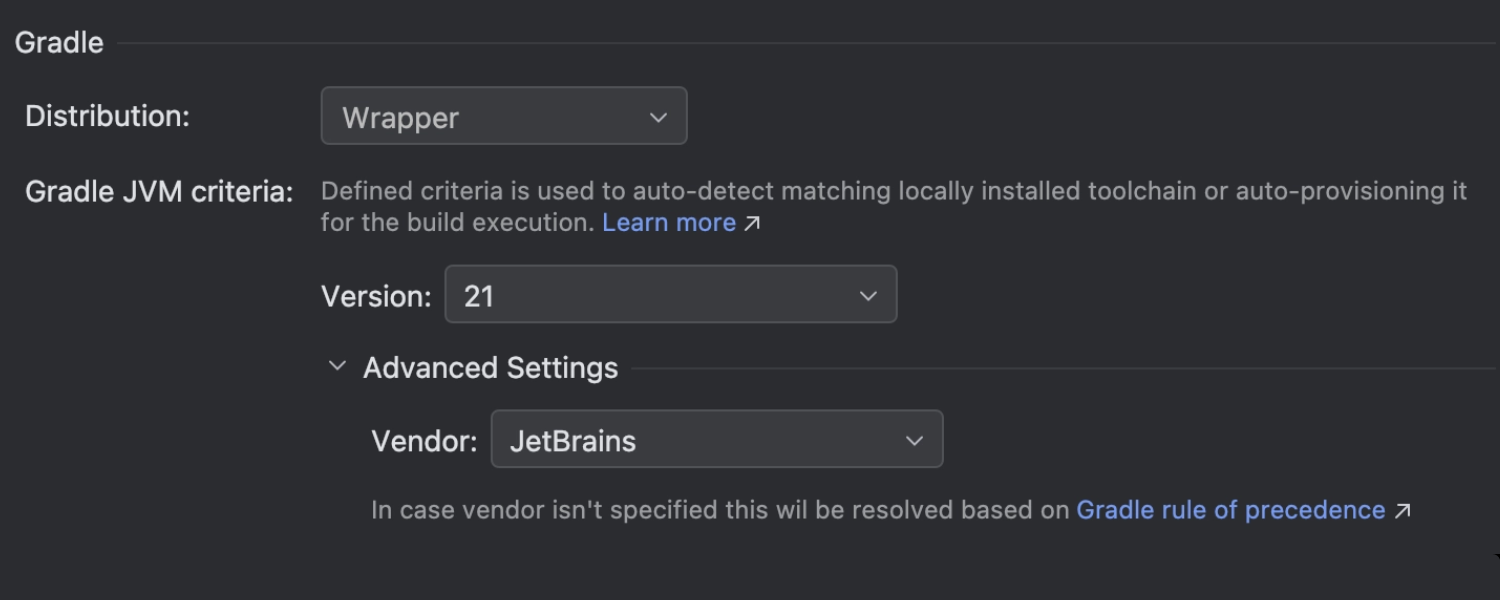
Support for Gradle Daemon toolchains
Starting with Gradle 8.13, you can now use the native toolchain to define the exact JVM for the Gradle Daemon, just like you do for the project itself. IntelliJ IDEA syncs with Gradle's configuration and even lets Gradle download the required JVM automatically if needed. The settings in Preferences/Settings | Build Tools | Gradle stay fully in sync with Gradle's config. While this setup is optional, we encourage you to use it to prevent Daemon JVM errors and ensure projects sync smoothly every time.
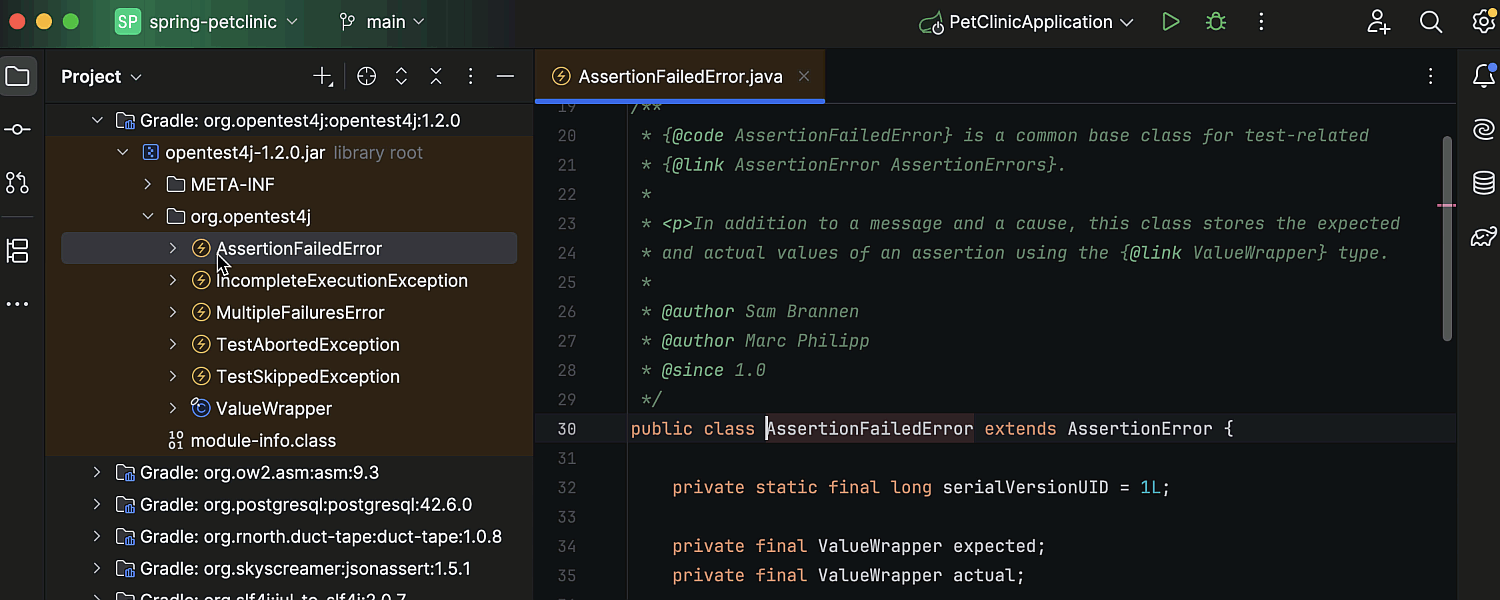
Automatic download of library sources for Gradle projects
IntelliJ IDEA 2025.1 makes it easier to access the source code of libraries when working with dependencies in Gradle projects. The IDE now automatically downloads the sources upon navigation to a relevant file. Previously, it relied on decompiled sources by default and only gave you the option to download the originals manually. With this update, you'll get well-formatted source code and accompanying documentation right away.
Improved support for multi-release JARs
IntelliJ IDEA 2025.1 improves the multi-release JAR support, making Maven project setup smoother and more reliable. Previously, additional source roots with different language levels inside a single JAR weren't recognized correctly during project sync. Now, the IDE properly handles them, streamlining this advanced workflow for the multi-release JAR generation introduced in Java 9.
Improved support for Bazel projects
Bazel is now ready for Java and Kotlin, offering essential features such as debugging, running and testing targets with coverage, and HotSwap. The Python support offered via the plugin is also enabled, including debugging for Python targets. Other improvements include phased sync, which lets you import and get to code faster, the ability to run all tests within a directory or target tree, context menu actions for copying target IDs, and a simple wizard for creating new projects. Learn more in this blog post.
Version control systems
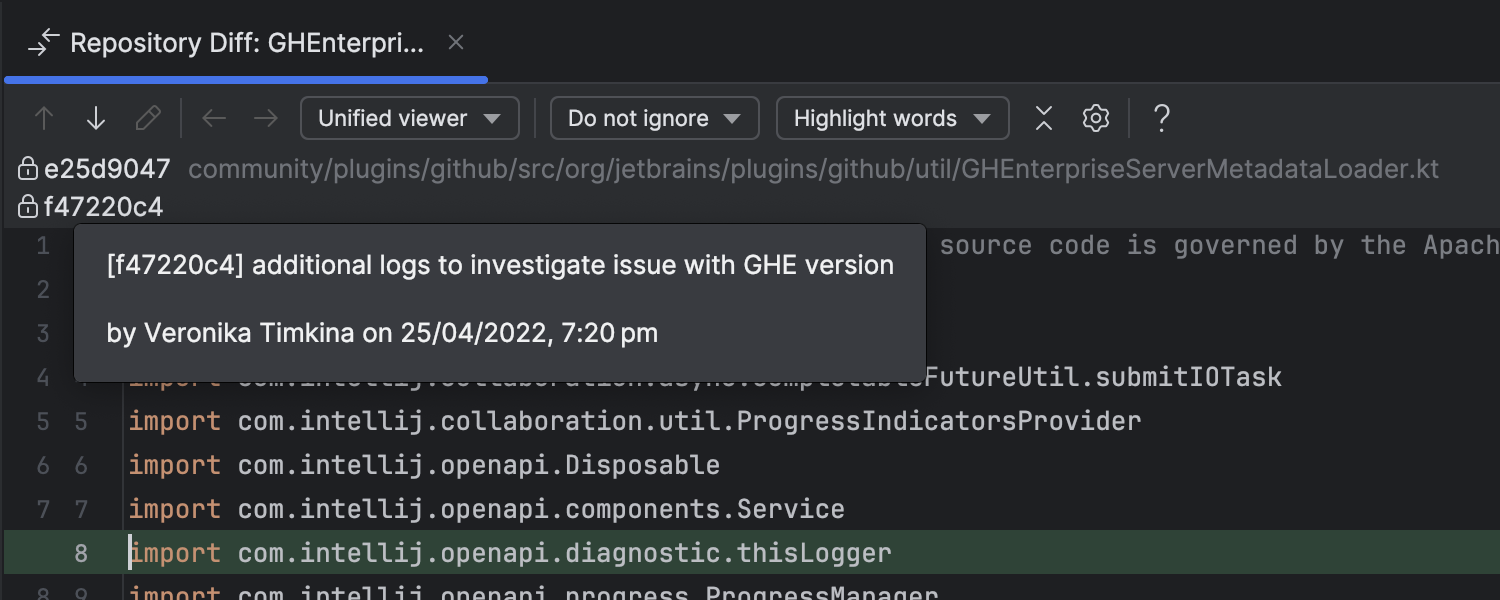
Commit details in the diff view
You can now see commit details directly in the diff view. The diff dialog displays the commit message, author, date and time, and full commit hash, giving you a clearer view of a file's history and helping you understand modifications faster.
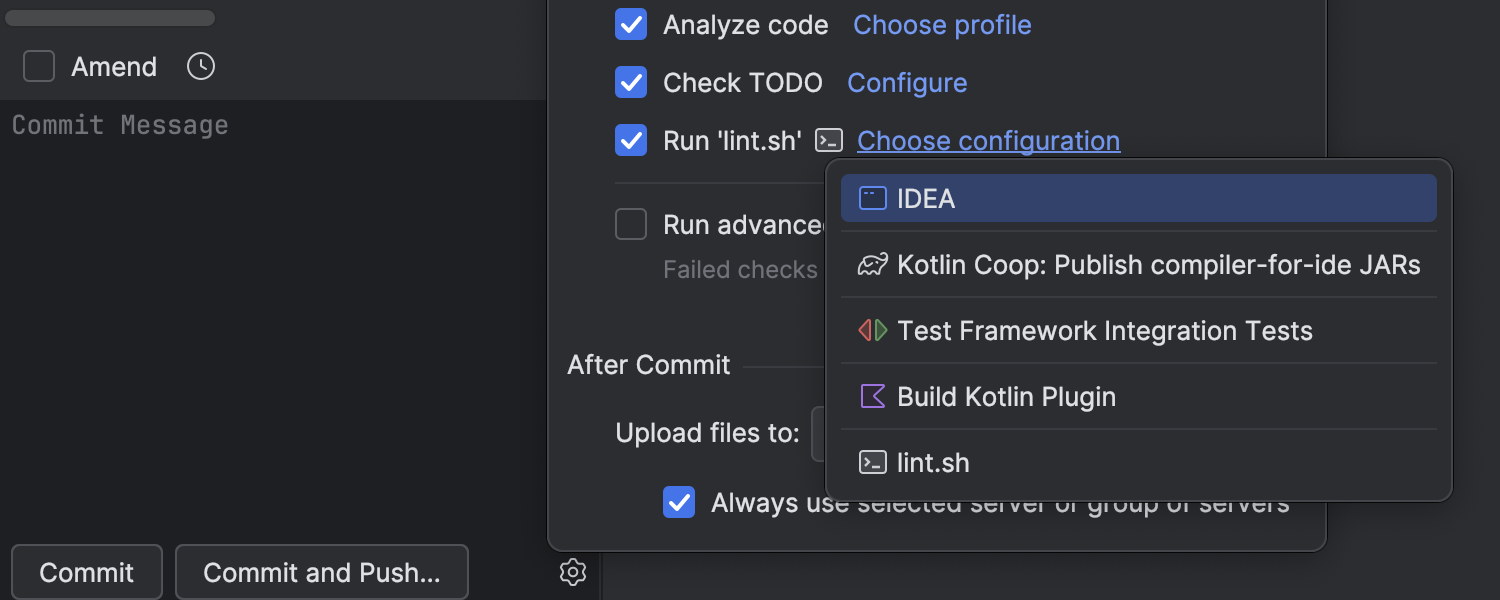
Option to run tools for pre-commit checks
You can now launch any tool to perform a pre-commit check alongside inspections and formatting. Custom checks can be configured as run configurations in the Run Configuration dialog. This helps you catch potential issues early and ensures your code meets project standards before it's committed.
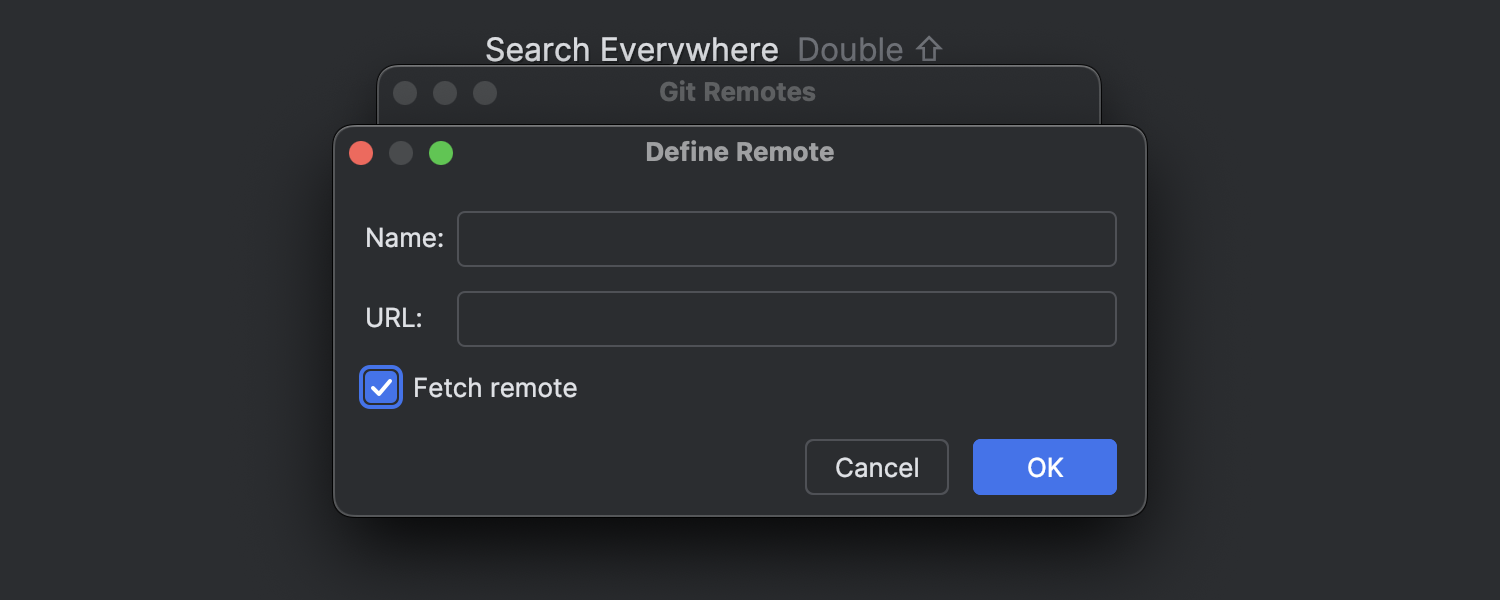
Automatic fetch when adding or modifying a Git remote
IntelliJ IDEA now automatically fetches changes when you add or update a Git remote, ensuring you always have the latest branch list and commit history without needing to fetch them manually. Newly fetched branches will immediately appear in the Git branch tree. You'll be able to start working with them right away, and your repository will always be up to date.

Option to disable the running of Git commit hooks
A new option allows you to instruct the IDE not to run Git commit hooks. Previously, Git hooks would execute automatically during commit operations, which might not have been desirable in all situations. With this update, you can now configure the IDE to skip these hooks, giving you more control over your commit process.
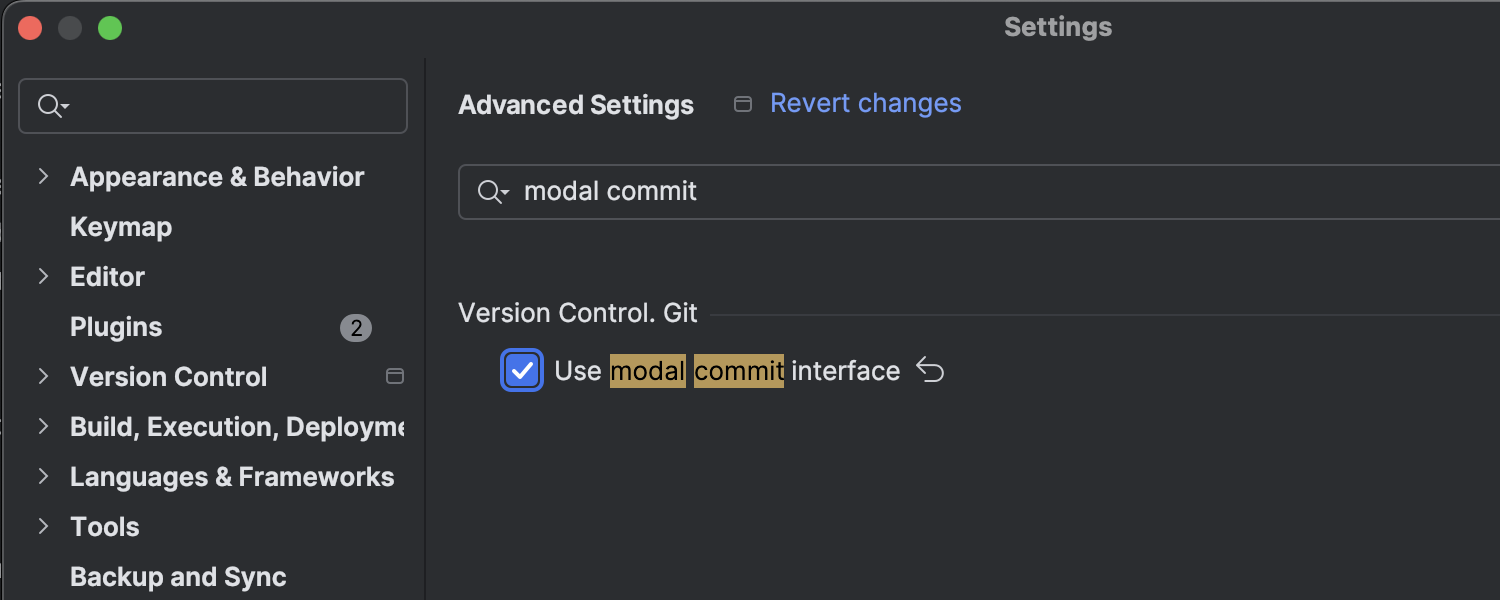
Commit experience updates
We are refining the non-modal commit workflow, the default built-in option, in response to the extensive feedback we received during the Early Access Program. The modal commit interface is becoming a plugin, which can be activated in Settings | Advanced Settings | Version Control. Git. In version 2025.1, the plugin will be bundled with the IDE, so you'll be able to continue using the interface without having to install it manually.
Debugger
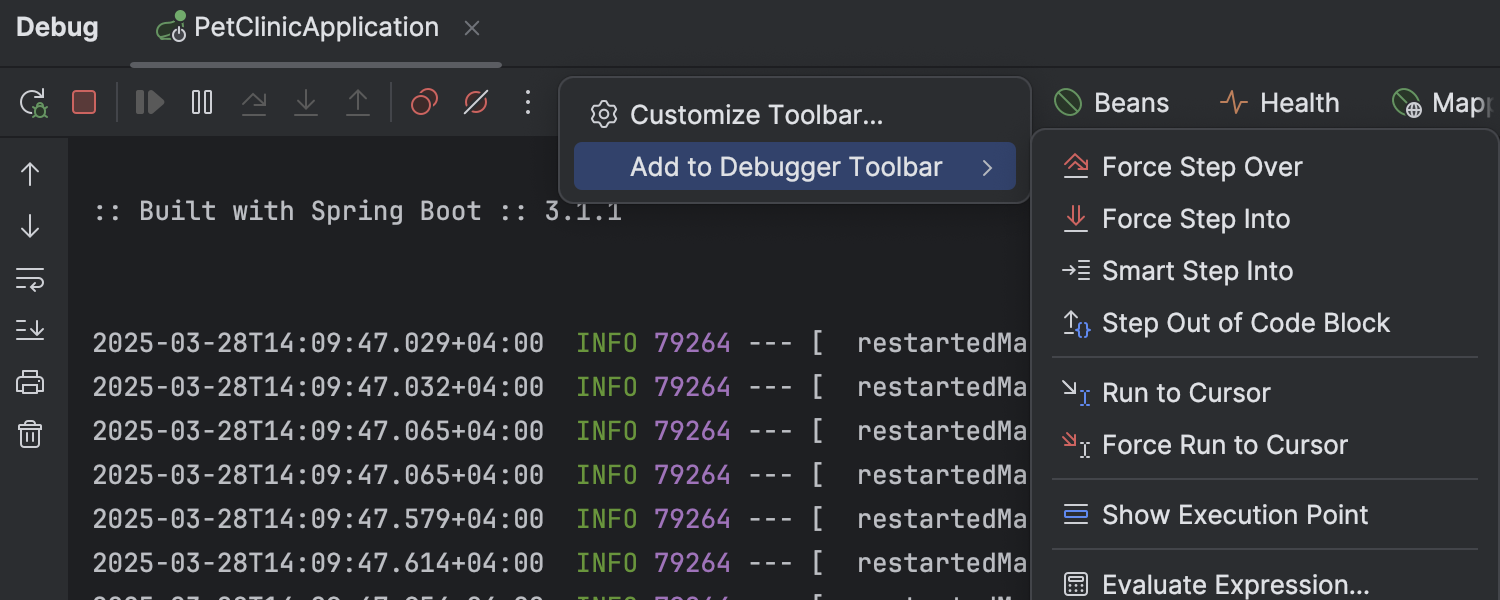
Easier toolbar customization in the Debug tool window
You can now customize the debugger's toolbar to better fit your workflow so you can take full advantage of its powerful features. Right-click next to the kebab menu in the top pane and select Add to Debugger Toolbar to see a list of available actions.

Text popups in inline hints
During debugging, when inspecting a value that contains markup text, you can now view it with proper formatting instead of as a plain, lengthy string. For example, if the value is an XML input for a parser, it will be displayed in a structured, readable format. This functionality, previously available only in watches, has now been extended to inline debugging so you can benefit from a consistent experience across both views.
Code quality and security
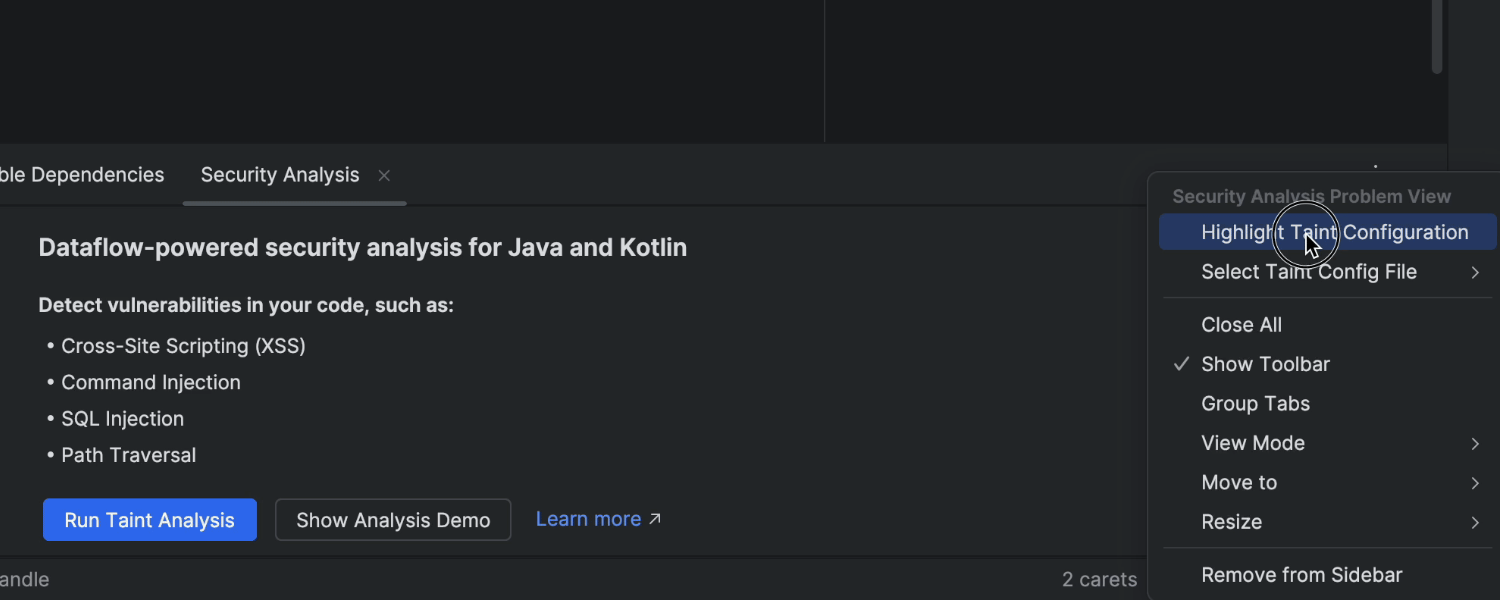
Security analysis by Qodana – new configuration and tooling Ultimate
Configuring taint rules for security analyzers can be a difficult and time-consuming task, often requiring a lot of manual effort. To simplify this process, we're introducing a predefined configuration that automatically covers common sources and sinks, built on various benchmarks and external providers.
Our security analyzer now includes predefined taint rules for the most common categories of OWASP Top 10:2021 vulnerabilities (A01, A03, A07, A08, A10). This significantly improves issue detection out of the box, minimizing effort on your end while providing broad security coverage.
Taint rules can be configured using .kts files, allowing you to define library and user code as sources or sinks. This flexibility ensures that the security analysis adapts to your project-specific needs.
To give it a try, visit the Problems view, open the Security Analysis tab, and install the Security Analysis by Qodana plugin, which is free for IntelliJ IDEA Ultimate users.
Web development

Angular improvements Ultimate
IntelliJ IDEA 2025.1 adds support for Angular 17.2 signal queries, smarter reactive form completion, and code completion support for host binding attributes based on directive selectors, with quick-fixes for creating fields within binding expressions.
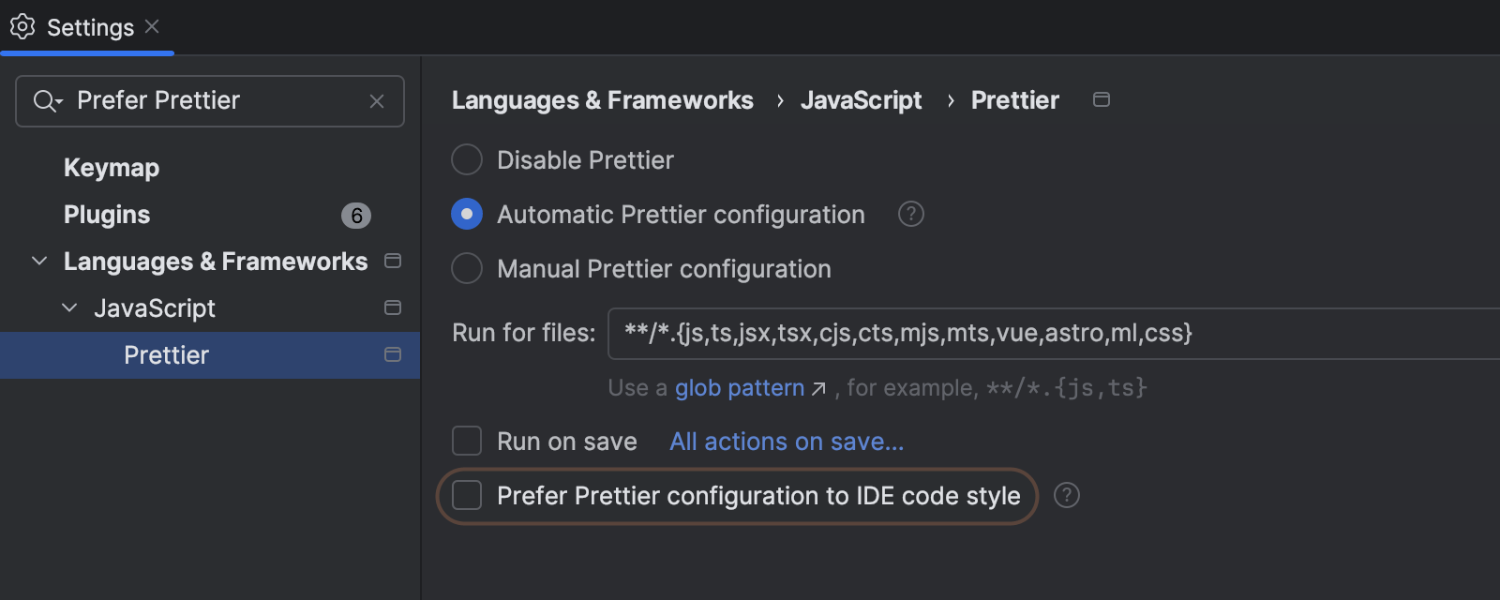
Better monorepo support Ultimate
Working in a monorepo just got smoother! The IDE now respects Prettier configs per subproject, offers smarter auto-imports and path alias resolution via improved exports handling, and delivers faster code completion and navigation in large Nx workspaces. Enjoy a more consistent and efficient coding experience across all your projects.
Database tools

Introspection by levels for MySQL and MariaDB Ultimate
We're continuing our work to enhance introspection performance. Starting from version 2025.1, there will be different introspection levels for MySQL and MariaDB, and the amount of metadata that gets loaded will automatically be adjusted depending on the size of your database. In other words, we won't load all the metadata if your database is large. This will significantly reduce introspection time and allow you to start working with newly connected data sources right away. To learn more about the levels and how to tailor your experience, visit this page.
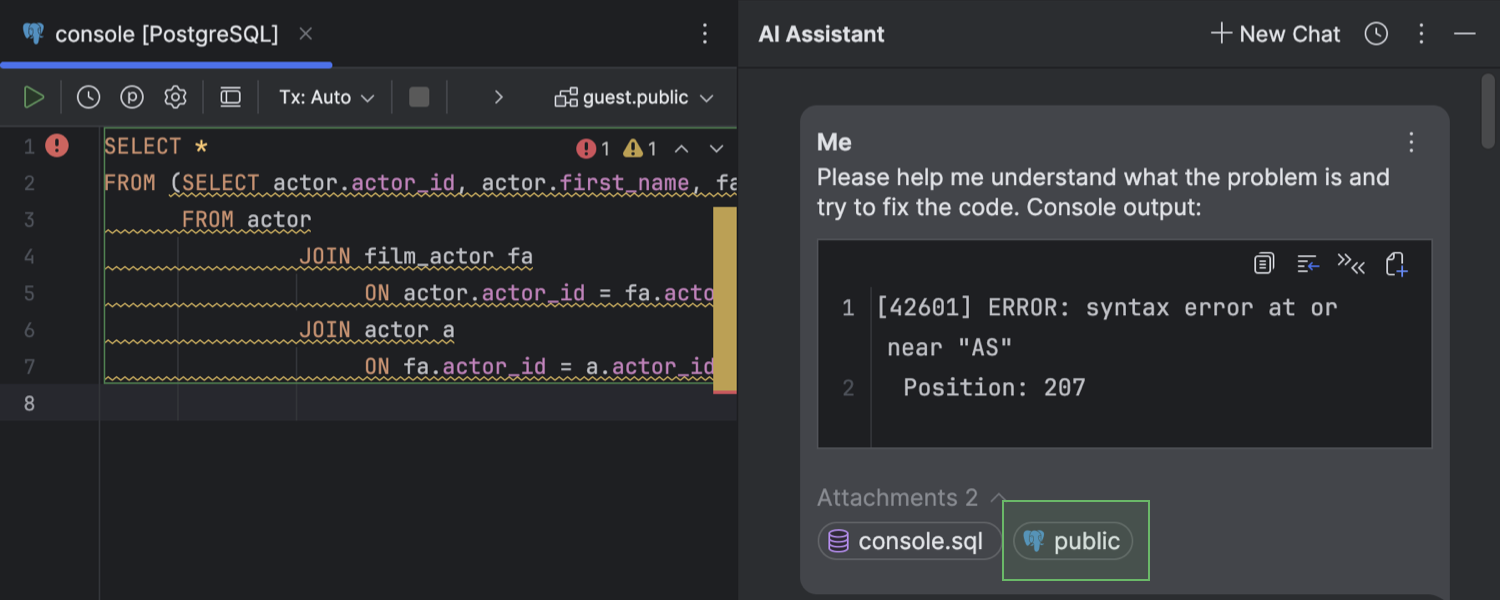
Attached schemas in the Explain with AI chat Ultimate
Explanations are more effective when they use all the relevant context. Now, when you ask AI Assistant to explain a query, the corresponding schema is automatically attached to the chat.
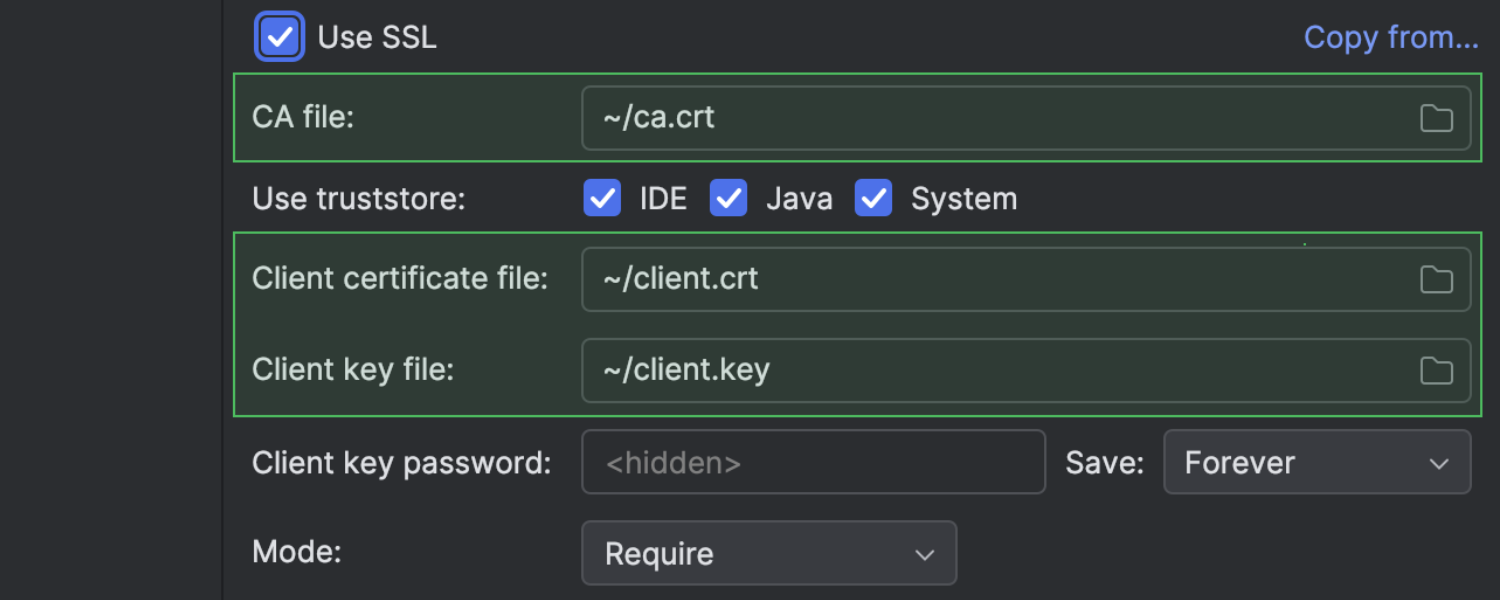
Support for tildes in path fields Ultimate
We have implemented support for the use of tildes (~) in the path fields for SSL certificates and BigQuery key files. Now, you can use the character to specify directories in the Data Sources and Drivers dialog. To do that for your SSL connection, open the dialog by pressing Ctrl+I, and select the data source you want to change the settings for. Then, open the SSH/SSL tab and navigate to the SSL section.
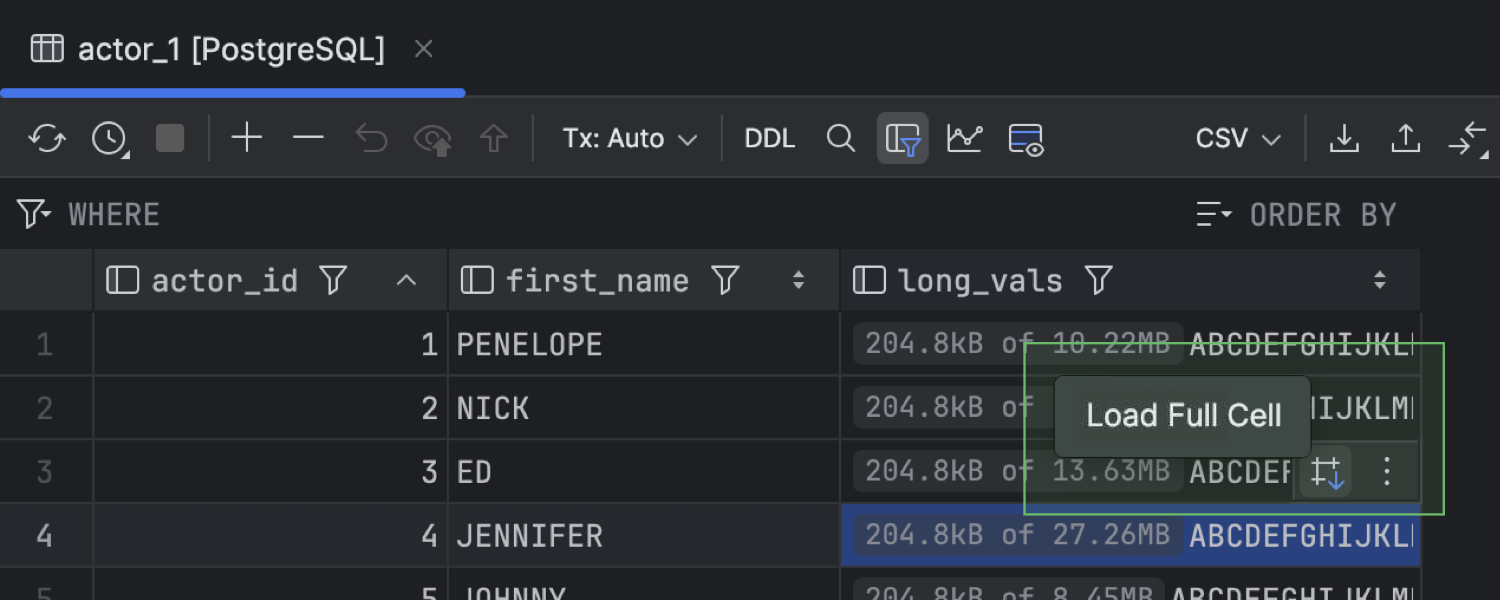
Support for loading full cell values in place Ultimate
There is now a setting that limits the amount of data that's loaded in each cell. Designed to improve performance when working with large tables, this option allows you to decide whether you want cells to be partially or fully loaded.

Geo-type data display Ultimate
For PostgreSQL, MySQL, and MariaDB spatial databases, IntelliJ IDEA can now correctly display geo types raw in the grid.
The ability to download drivers from Maven or other custom repositories Ultimate
Version 2025.1 allows you to add custom repositories for downloading drivers. To do so, add the repositories you need to the mirrors attribute of the HOME_PATH/.m2/settings.xml file.
Other
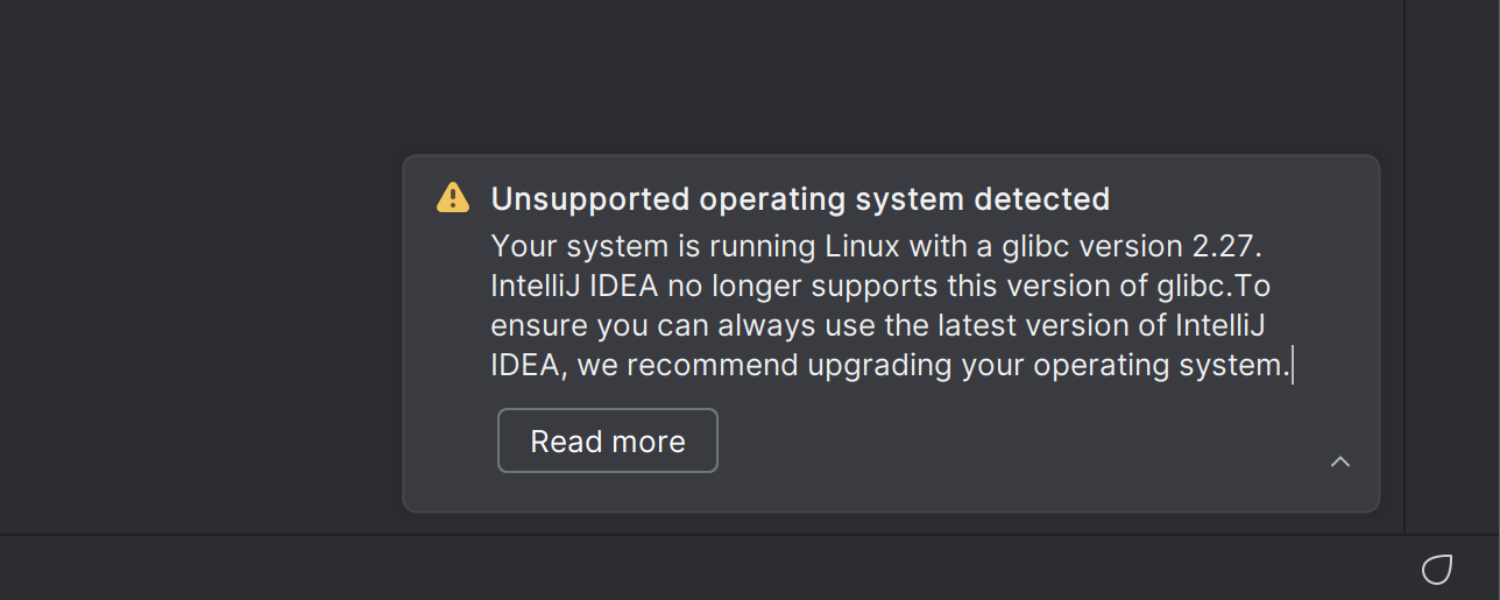
Deprecation of support for glibc versions below 2.28 on Linux
The IDE no longer supports Linux distributions running glibc versions below 2.28. If your system uses an unsupported version, IntelliJ IDEA will display a warning on startup.
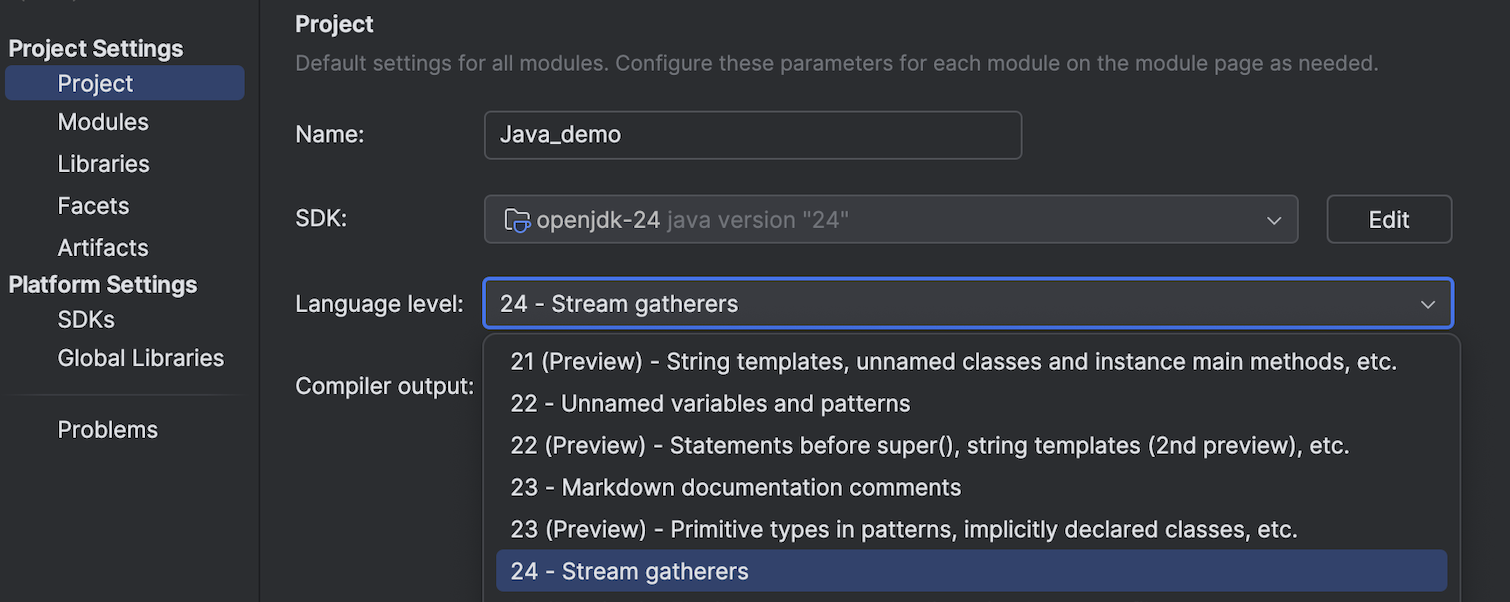
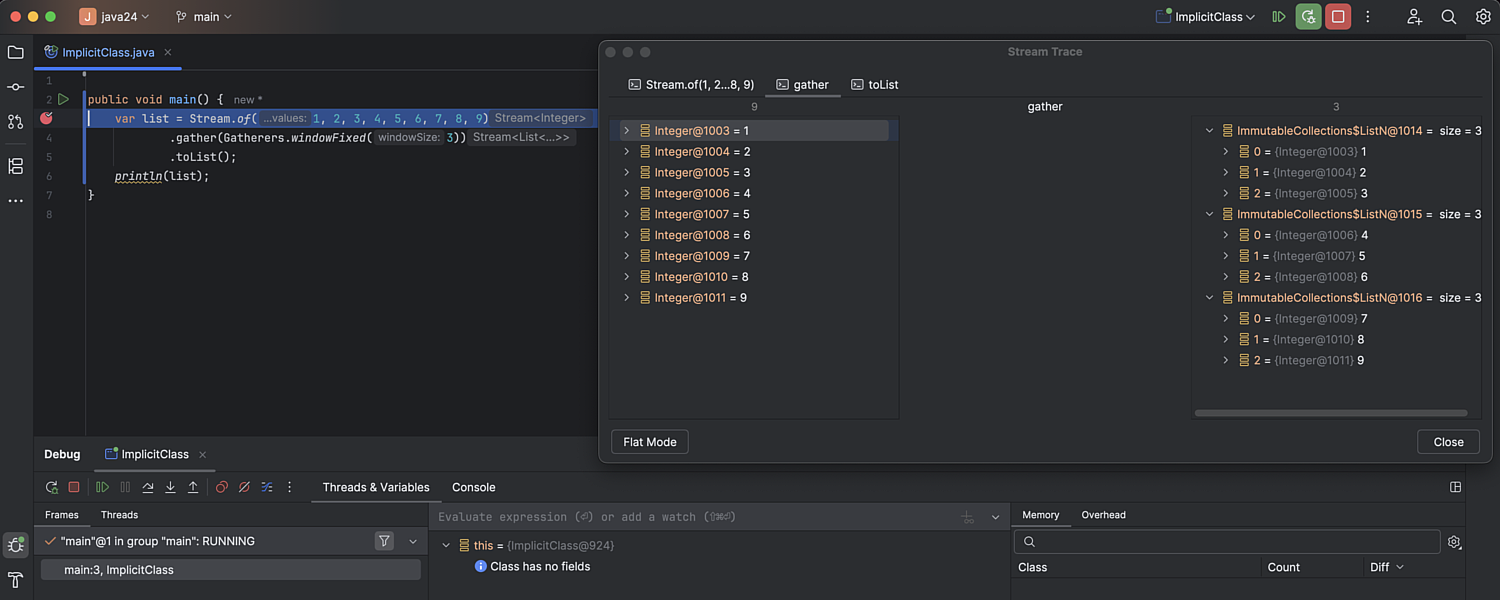


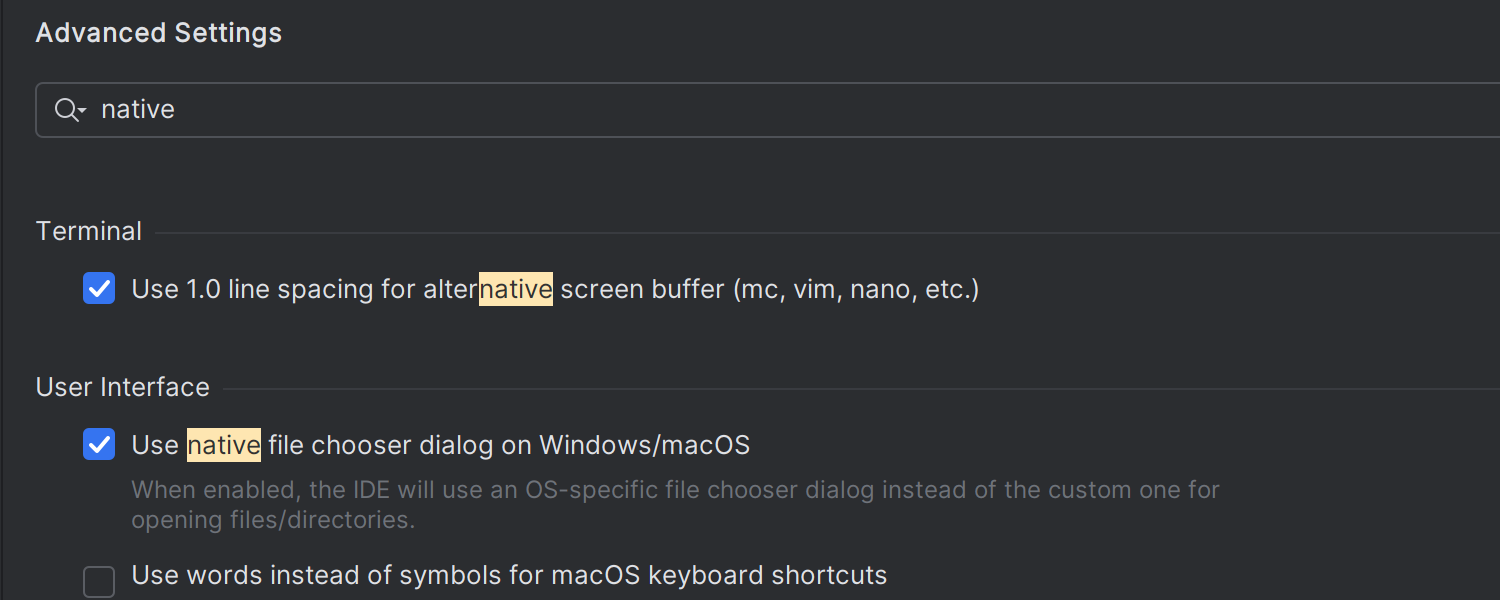
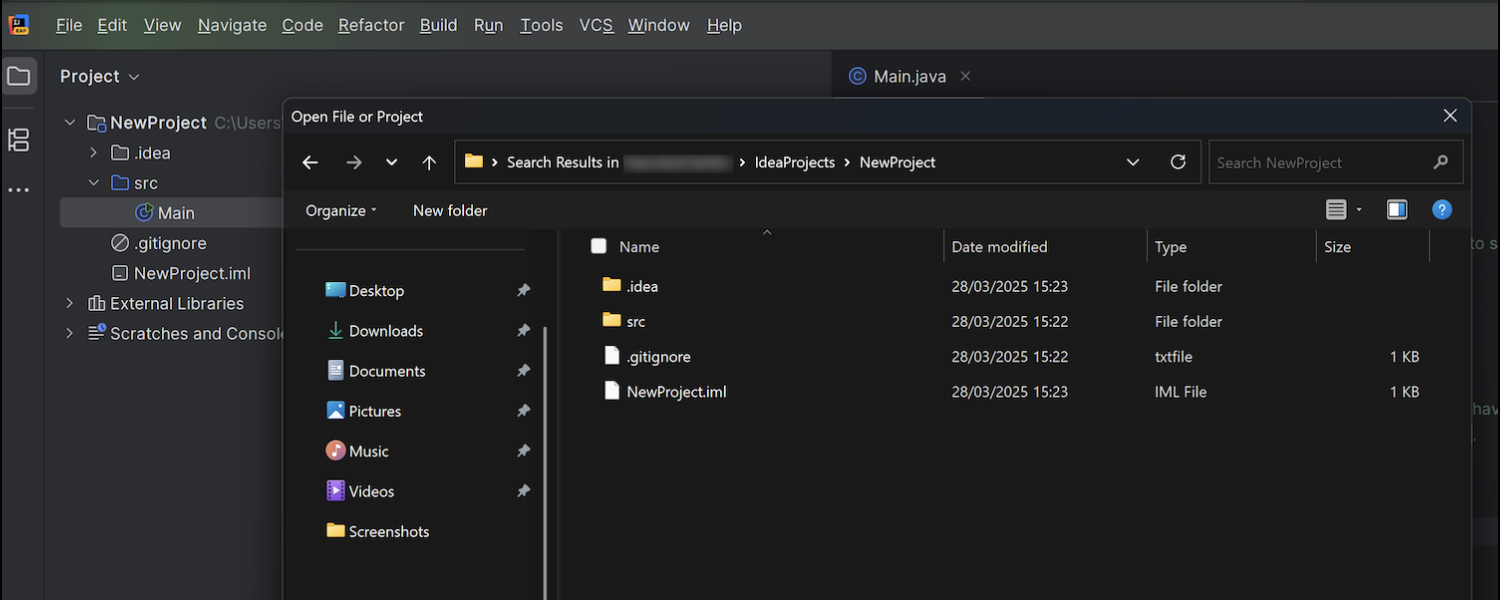

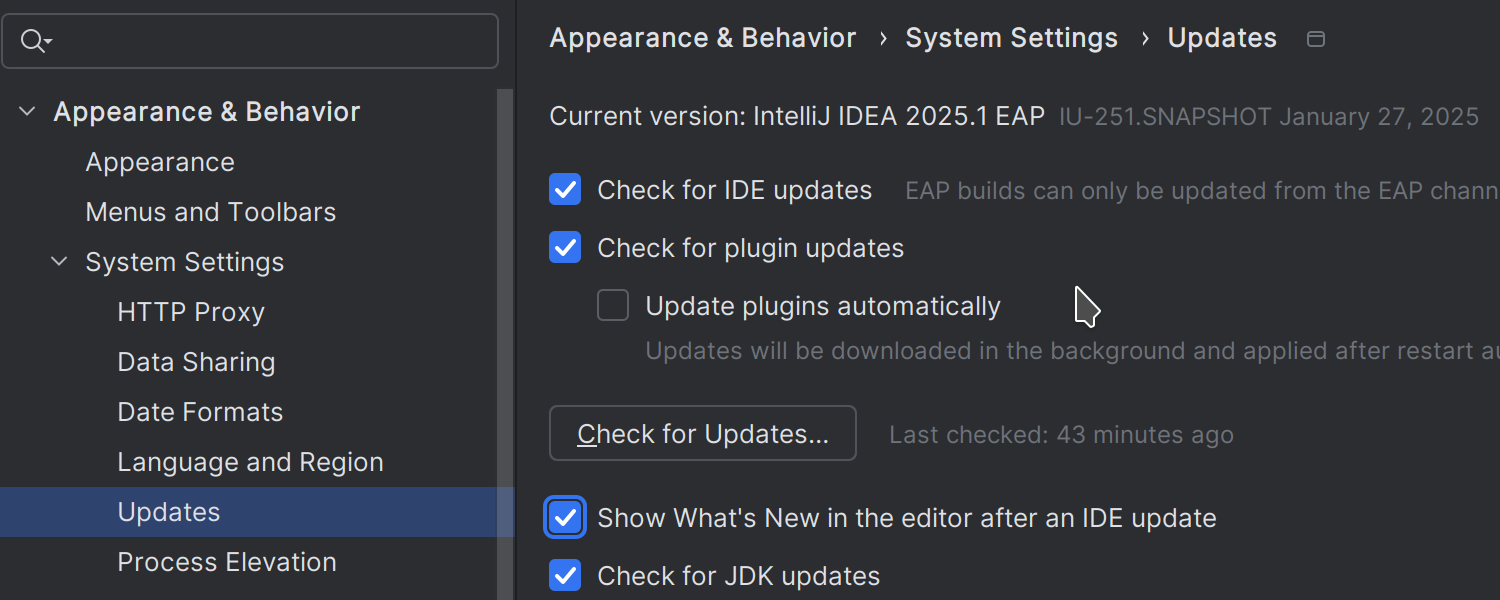
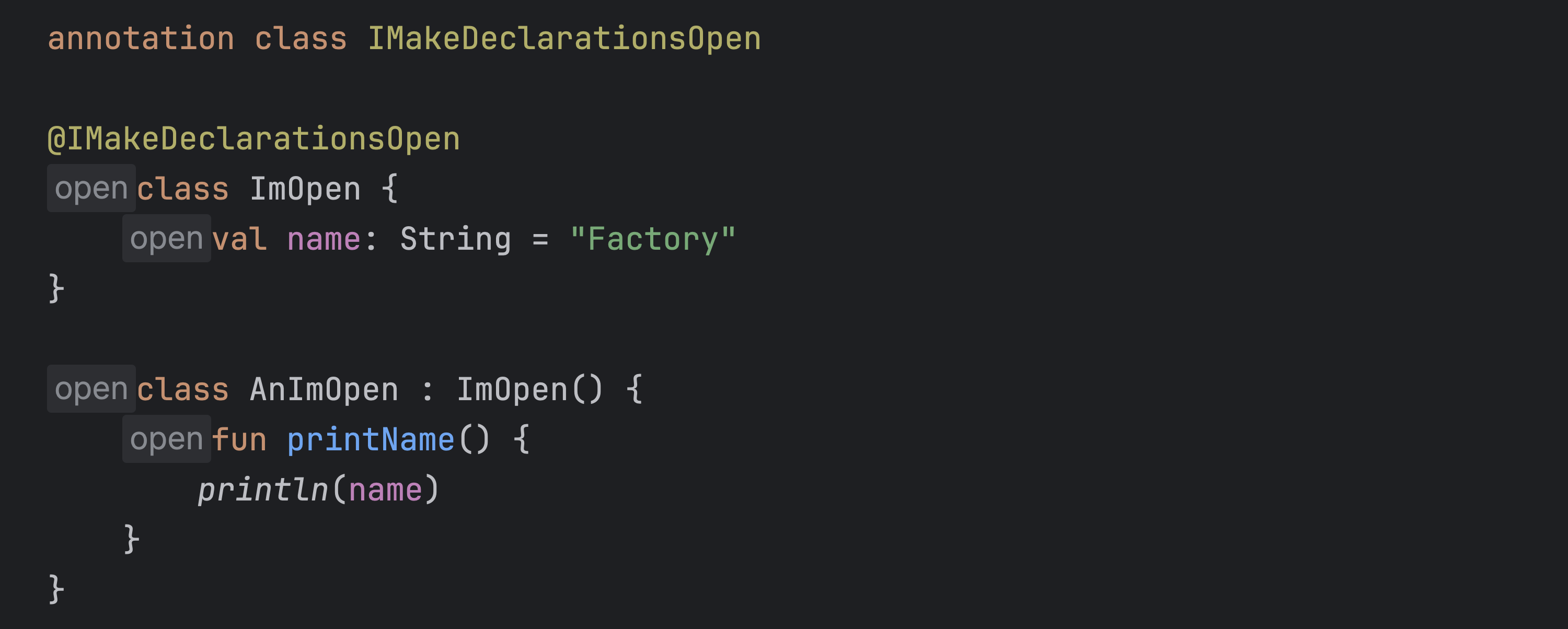
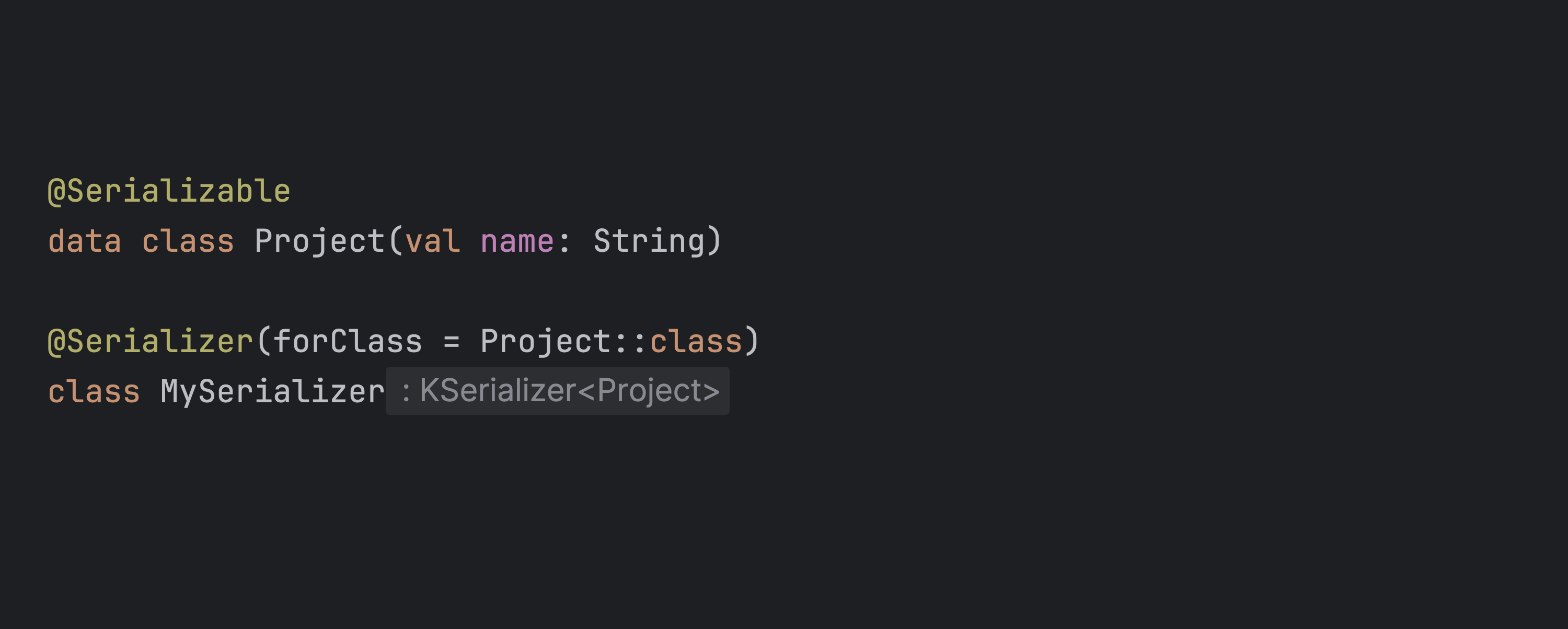
Tell me about new product features as they come out
Follow us